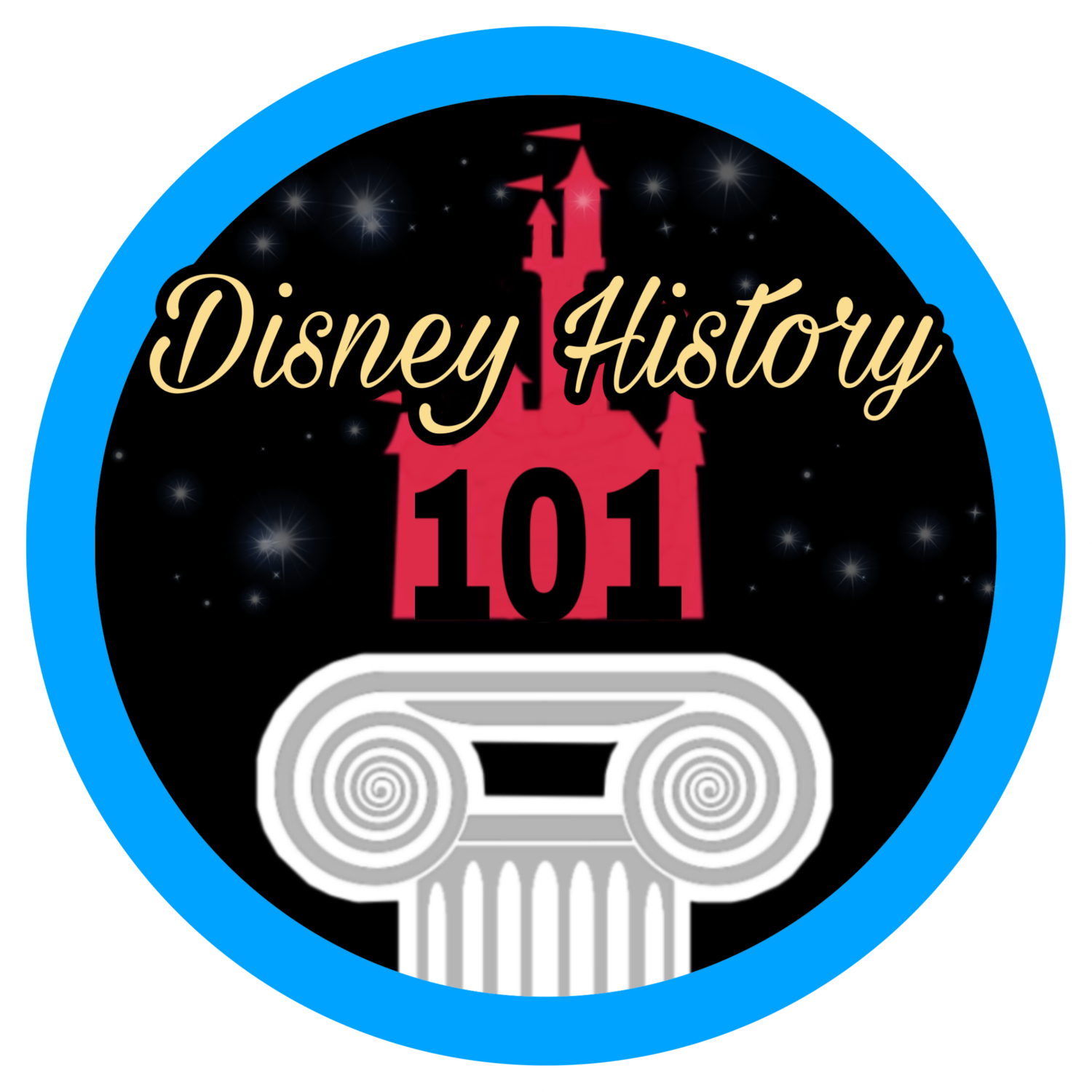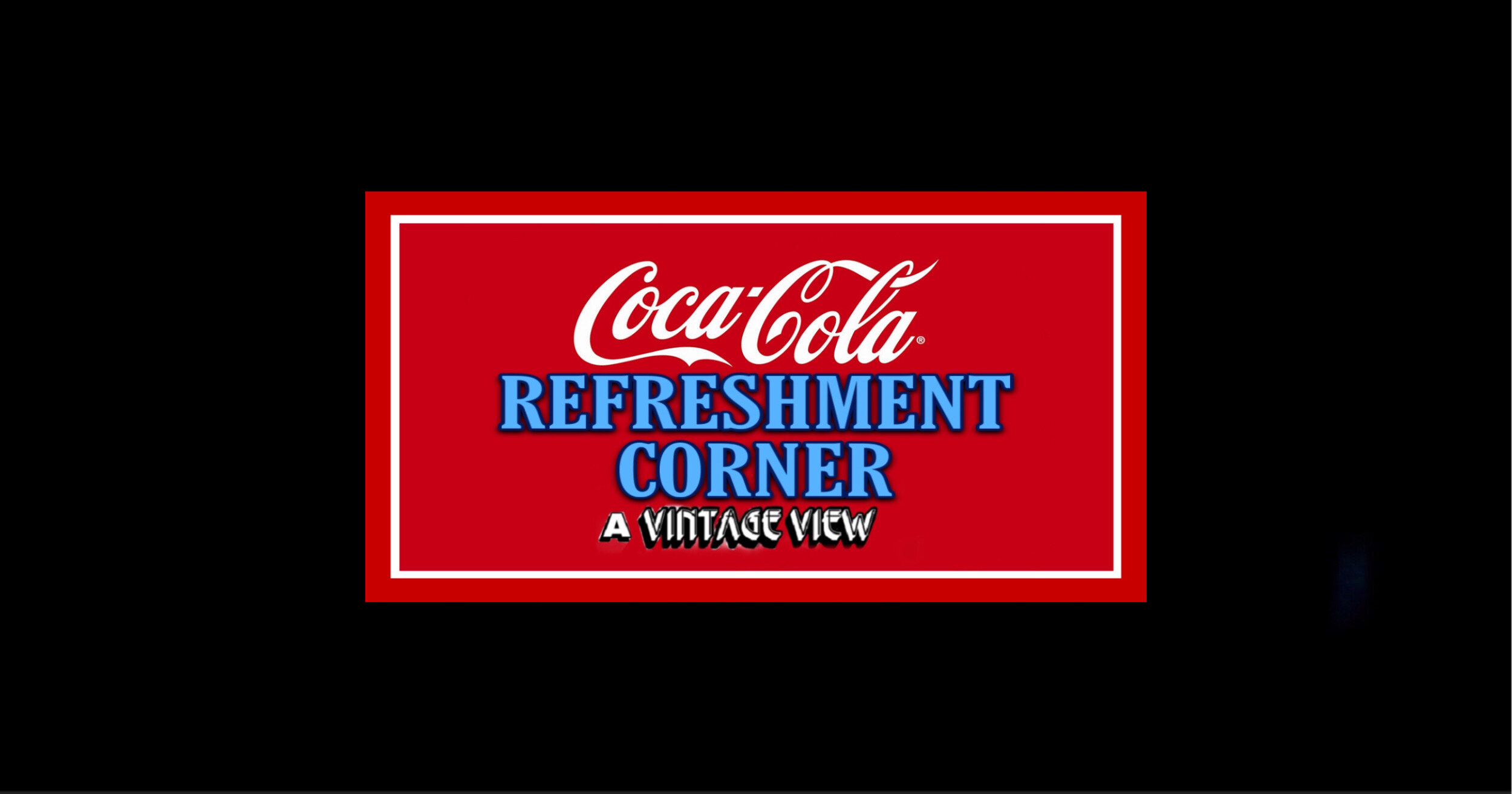COCA-COLA REFRESHMENT CORNER
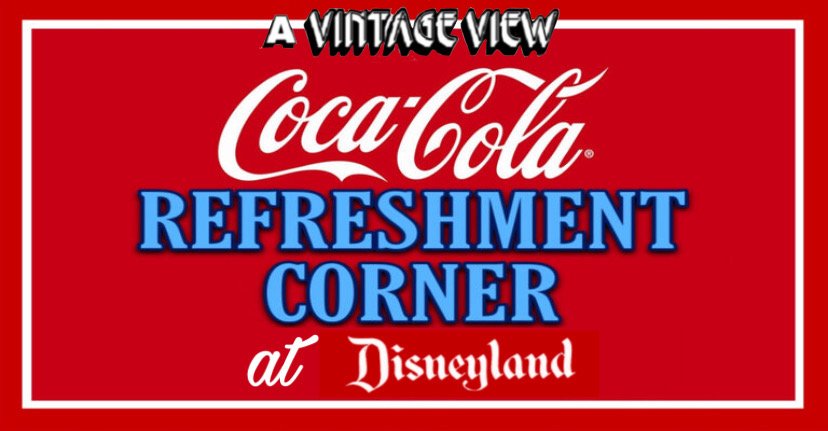
(July 15, 1955 - present)
![Back in 1948, Walt was dreaming about a Park (to be located across the street from the Studio in Burbank). Some thoughts in the “Mickey Mouse Park” prospectus made mention of a “soda fountain.” [“The Spirit of Disneyland”] Fast forward to 1951,](https://images.squarespace-cdn.com/content/v1/5b3d7f804eddec6e826be0c9/1652735111840-4KSZW7W5Q5OPQCSTMKTC/3289F0DB-CFD2-4B59-B761-F8BC92836ACE.jpeg)
Back in 1948, Walt was dreaming about a Park (to be located across the street from the Studio in Burbank). Some thoughts in the “Mickey Mouse Park” prospectus made mention of a “soda fountain.” [“The Spirit of Disneyland”] Fast forward to 1951, when Walt Disney and Art Linkletter visited the famous entertainment complex Tivoli Gardens in Copenhagen. He was researching and talking notes to build a family entertainment center and Tivoli was much like what he envisioned. It was clean, directed to the entire family, fun, entertaining and educational. Walt noted how important it was to have a lot of places for guests to sit down and a wide variety of eating spots that served excellent meals.
Eventually, the idea grew into Disneyland and by 1954, Walt was searching for participants to lease shop and restaurant spaces at Disneyland, and help generate the necessary capital to fund construction of the Park. In a synergistic relationship, the companies (in turn) could sell their products and advertise their corporate names within Disneyland. Disneyland Participant Corporate Sponsors were carefully selected. High quality, long term corporate sponsors would provide incremental income that enabled Disneyland to enhance its show and attractions, offset some operating expenses, and capitalize on marketing opportunities.
Several of these “reliable old firms” sponsored the “abundance of restaurants devoted to pleasing all tastes and all budgets,” according to “The Story of Disneyland,” published 1955. Since 1955, the Coca-Cola Company had been an occasional sponsor of portions of Walt Disney’s Mickey Mouse Club television variety show, so this new relationship with Walt Disney Productions seemed like a natural progression.
“55er” Rima Bruce (who started with Jim D'Arcy in Food when all food was Lessee and typed memos and menus) recalled that “the phone never stopped ringing with everybody trying to get a food lease in the Park.“ By July of 1954, Raul Grizante of Disneyland, Inc. was overseeing food philosophy, area & location, food specialties, and beverages for Disneyland. Individuals like Nat Wyncoff provided the essential orientation for curious lessees, selling Coca-Cola on the idea of Disneyland.
Nat brought along various visual aids like sketches and one of Herb Ryman’s oil paintings of Disneyland. After negotiations, an agreement was reached, and the joint partnership (of the Coca-Cola Company and Coca-Coca Bottling Company of Los Angeles) became one of forty-seven lessees to sign a contact with Walt Disney Productions (in regard to Disneyland).
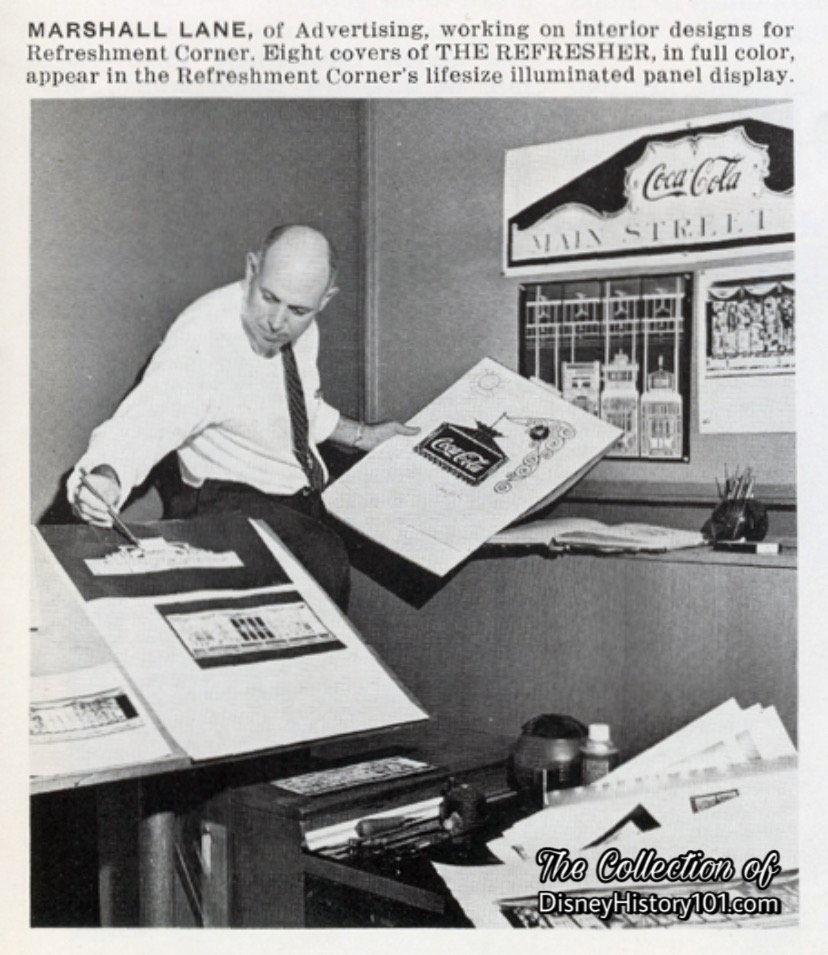
“Draw Concept” - Excerpt from The Refresher preserves Marshall Lane working on Show Elements like that iconic lamp, September, 1955.
By July 1, 1954, George Whitney of Disneyland, Inc. directed Amusements, with Ron Miller overseeing analysis, philosophy, capacities, planning, operator training, and amusement procurement. Soon, the design and engineering was spearheaded by Marshall Lane and N.C. Harrison, Jr. of Coca-Cola Advertising. Like some advanced “High Concept,” final designs were quickly generated and approved. Some of these viable project Concepts (as seen above), were supported by a well-developed business case and built expectation.
“Architectural Designs by Lessees”
Disneyland, Inc. printed materials for Lessees detailing specifications for architectural designs of exhibit spaces. These were revised by March 16, 1955 and issued to Lessees.
All of the interior architectural drawings were done by competent registered architects or an approved display house of the lessee's choice. All of the designs submitted by the lessee's architect, whether for buildings or construction of interiors in DISNEYLAND, were approved as to the theme and general plan of DISNEYLAND as established by WED Enterprises, Inc.
Three sets of preliminary drawings were furnished DISNEYLAND, Inc. as soon as possible after signing of the lease. Two sets were retained by DISNEYLAND and one set was returned to the lessee’s architect with any revisions noted thereon and stamped “APPROVAL TO PROCEED TO FINAL DESIGN.” This stamp when properly signed and dated constituted the lessee’s authority to proceed with the final drawings.
The Lessees revised their final drawings to incorporate any revisions noted on the approved preliminary drawings, and submitted three sets of the revised drawings to DISNEYLAND. One set was returned to the lessee’s architect and any revisions noted thereon are to be incorporated on the original drawings. When the lessee had incorporated the final revisions on the drawings, two sets of transparent ozalids were forwarded to DISNEYLAND for approval. DISNEYLAND would stamp both sets “FINAL DESIGN APPROVED” and “LESSEE’S CONTRACT DRAWINGS”, and return one set to the lessee who could then release drawings for bid and/or construction.
While previews of the exhibits and shows of other Main Street U.S.A. Disneyland Participants (Carnation Company, Gibson Greeting Cards, Swift & Co., etc.) appeared throughout the “Disneyland” supplement (published July 15, 1955), the Coca-Cola Company was notably absent. However, a brief story of the exhibit’s progress was published in “The Refresher,” a Coca-Cola employee periodical. Before Disneyland opened, an article published in Pacific Coast Review (published July 15, 1955), briefly and ambiguously mentioned that “Coca-Cola's bar features a mage disappearing act for empty bottles.”
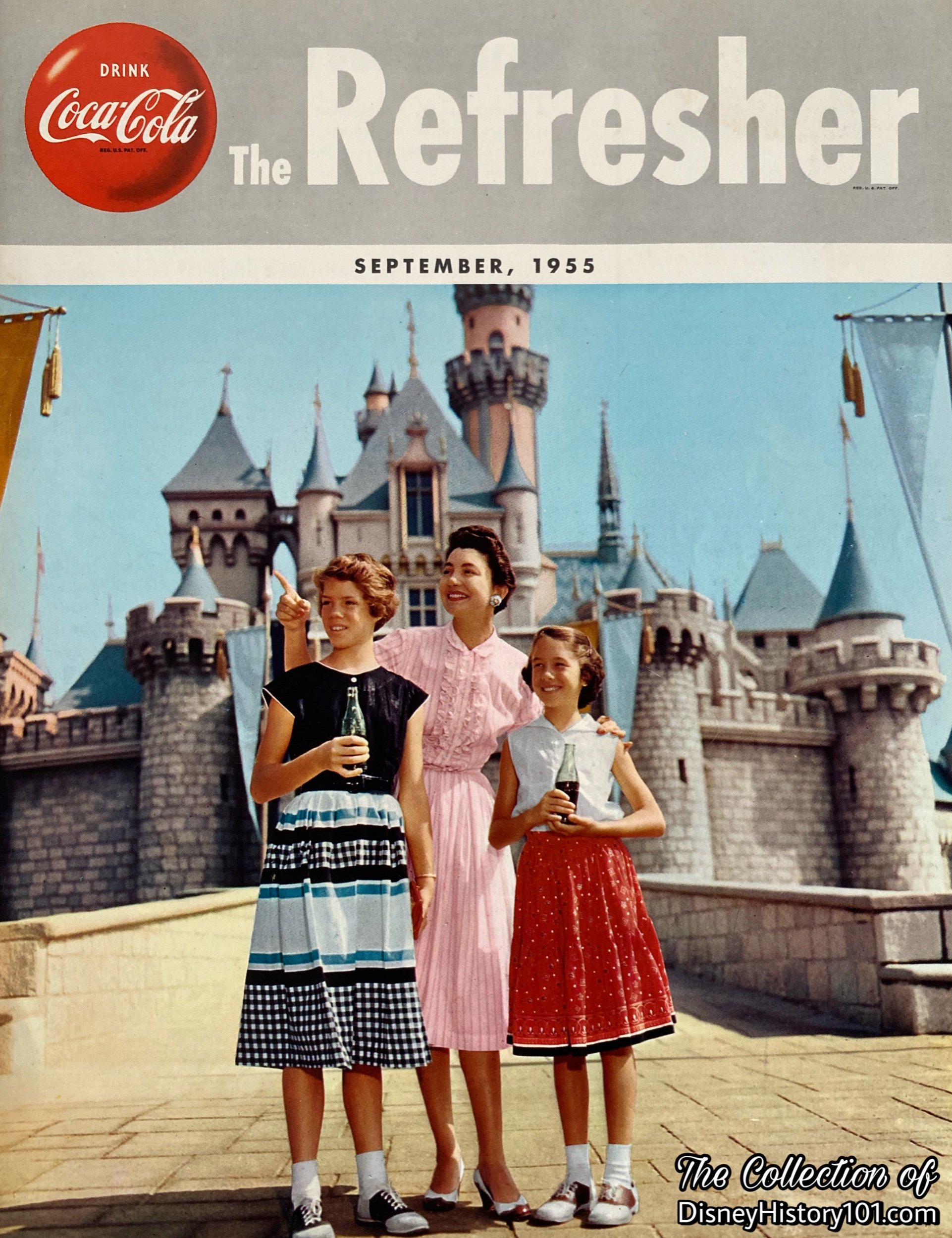
The cover of “The Refresher,” September 1955.
It’s interesting how much Disneyland’s corporate sponsors interacted with each other even during this formative era before the Park opened. Among The Refresher’s articles were items about Richfield Oil Corporation’s various telecast shows (which included a televised tour of the the Coca-Cola Bottling Company of California at Oakland). Of course, the highlight and cover story focused on the Coca-Cola Refreshment Corner on Main Street U.S.A. at Disneyland.
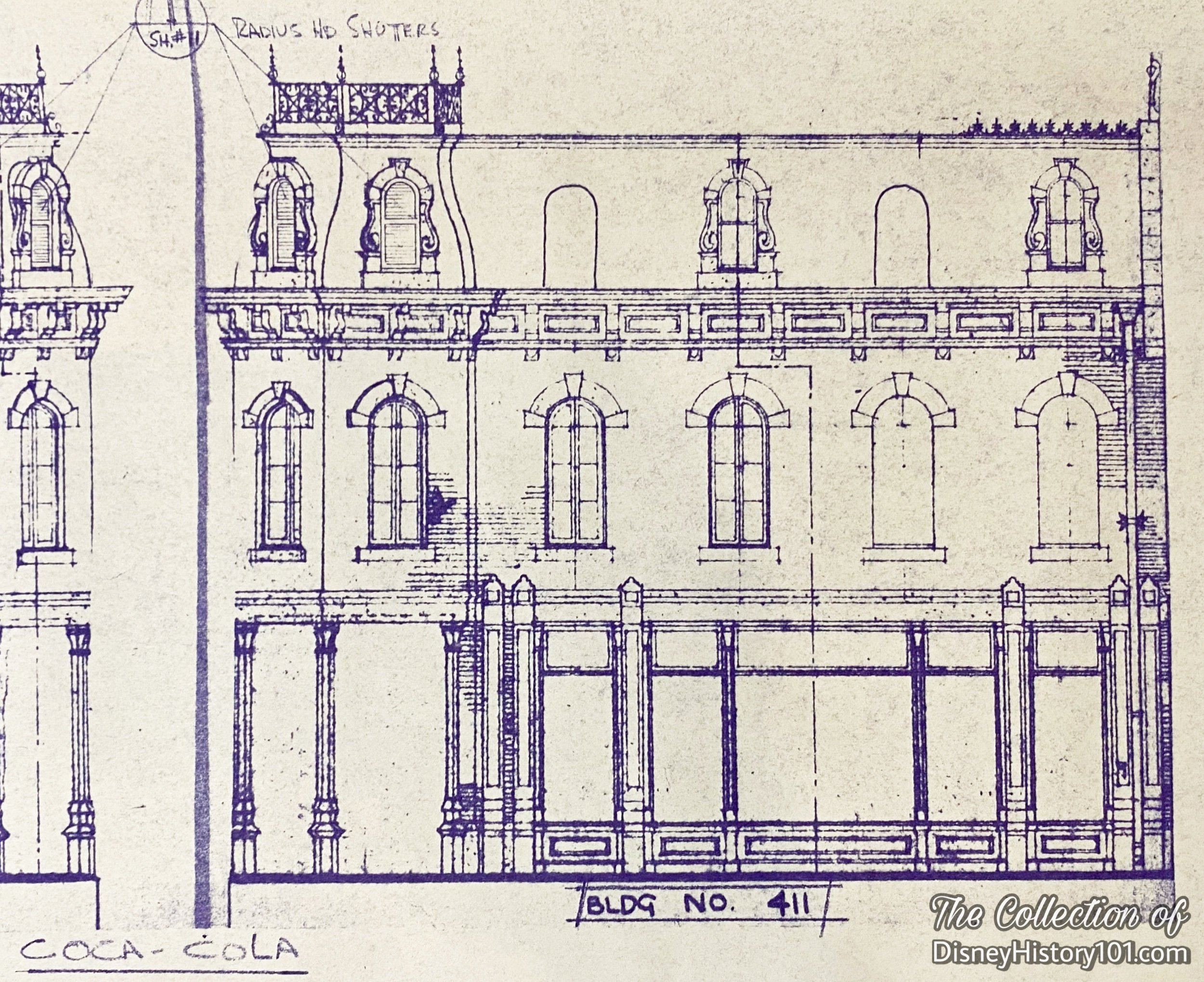
“Main Street 400 Block” Architectural Facade by Art Director Harvey Gillett of WED Enterprises for Disneyland, Inc., c.1961.
Next, architectural drawings of the three-story building helped define all designs, production and construction strategies, costs, schedule, and resource requirements. “Disneyland is unique in that some of the world's foremost creative artists and architects control all design at Disneyland.“ Models explored the various dimensional relationships, site-lines, flow patterns, ergonomics, and visual appeal to convey the desired creative intent.
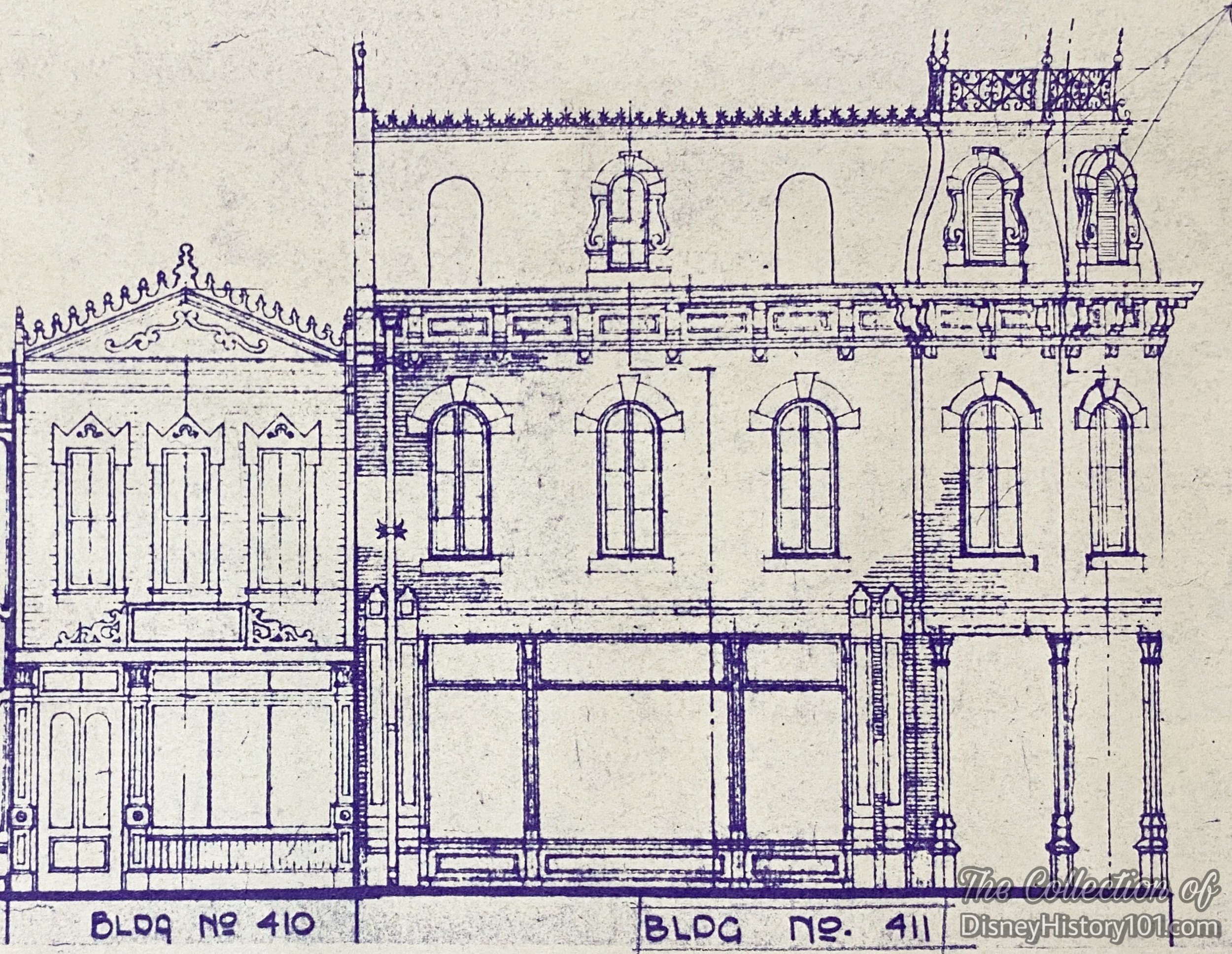
“Main Street 400 Block” Architectural Facade by Art Director Harvey Gillett of WED Enterprises for Disneyland, Inc., c.1961.
Then construction of Main Street Building #400 began. F. M. Franz, manager of operations for MeNeil Construction expressed: "We feel sure there has never been anything built like this in Southern California, or elsewhere in the United States. Many of the items were constructed from artist’s sketches.”
Forced perspective would make the buildings on Main Street appear taller than actually are. On Main Street the buildings would not be full scale. Ground floors were built about 9/10ths scale. Second floors measured up to 7/10ths scale. The scale on the uppermost floors would be smaller still.
First, a concrete foundation and slab floors were prepared, followed by wood frame construction (while store units would have a combination wood and rigid steel frame).
According to inserts published in area newspapers during July of 1955, Disney buildings were roofed by Pioneer Roof & Shingle Company (then located at 608 Mateo Street, Los Angeles, California; 7522 Westminster Avenue, Westminster, California). The roof covering was a variable, dependent on the architectural design.
“Newbery Electric Corp. took the rapid electrical con-structión of Disneyland in stride. The electrical installations were supervised by Roy J. Gruendler, manager of Newbery's Orange County district office located at 1335 Santiago Ave, Santa Ana.” By June 30, 1955, related Disneyland Site Work Fire Protection Utilities Plot Plans were prepared for Disneyland Inc., by J.E. Thomasson of WED Enterprises Inc.
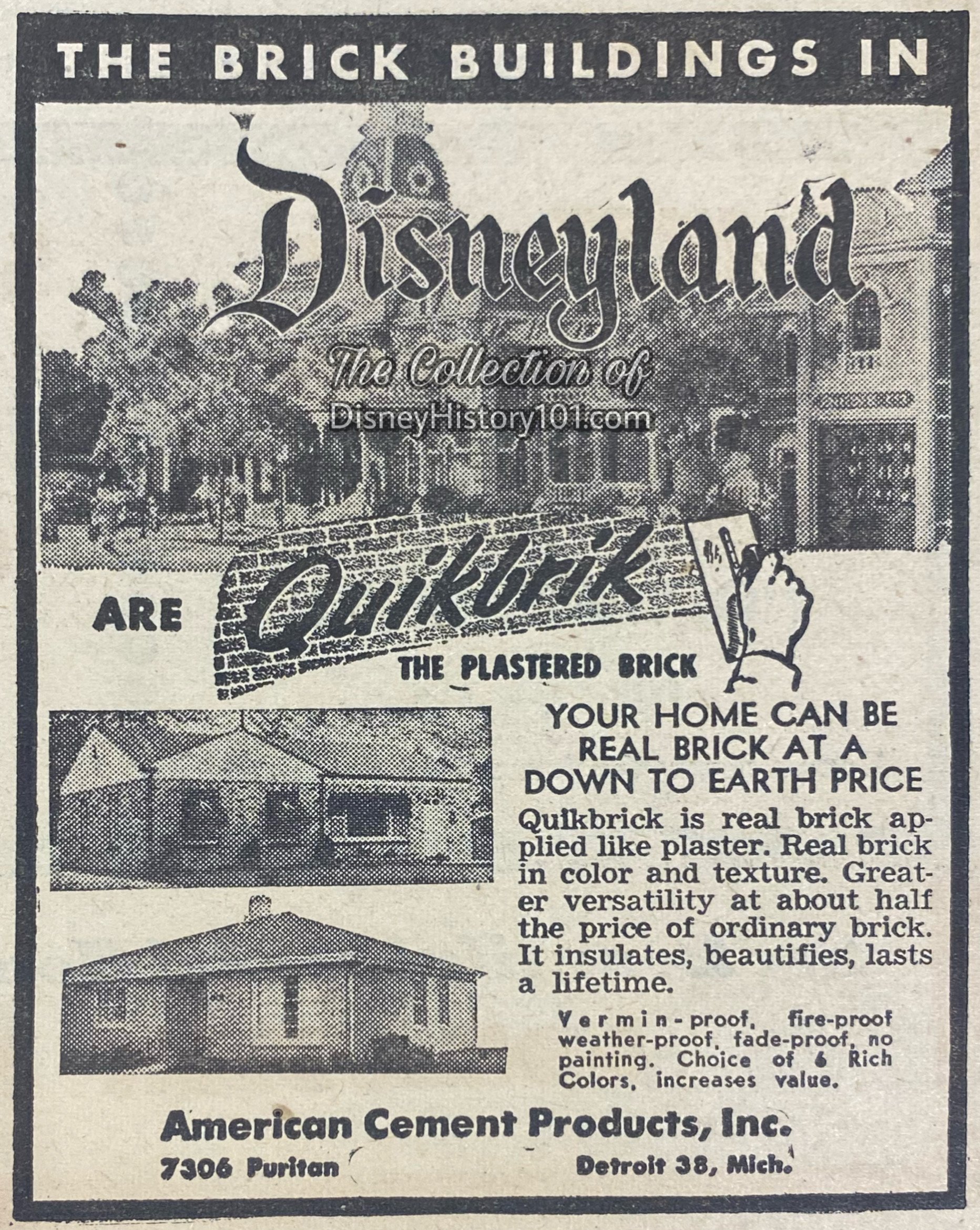
Larson Brothers Plastering Company of San Diego was a proud part of Disneyland. The company crafted the ornamental plastering and all brick used at Disneyland (including their amazing new plastered brick veneer).
The versatile Quikbrick (real colorful and textural brick applied like plaster) was about half the price of ordinary brick. It insulated, beautified, and was meant to “last a lifetime.” It was used on the facade.
The shop (as each on Main Street U.S.A.) possessed complete fire sprinkling systems. Ultimately, construction was wrapping up on the 1,283 square foot shop with an additional 1,775 square-foot basement under Disneyland.
By July 2, 1955, shadow gags were ordered. Painted signs, window, curtains, and shades were projected to be completed on time. The sound equipment was be installed, with completion of the tape recordings appearing to be fairly tight. As of June 2, 1955, C.V. Wood Jr. sent an Inter-Office Memorandum to Walt Disney regarding the best estimates that could be obtained at the time regarding the status of individual sections of the Park and Opening Day. C.V. wrote: “Building #410 - Coca-Cola: It is now estimated that this will be complete by the first of July.” As for the electric signs, a they were “in work,” and with the exception of the shoe store and the Bank of America, were to be completed.
As a sidelight, this was the only building in Disneyland with a basement. Soon, “the sign of good taste” was hung over the Architectural Facade at the corner of West Plaza and the 400 block of Main Street U.S.A.
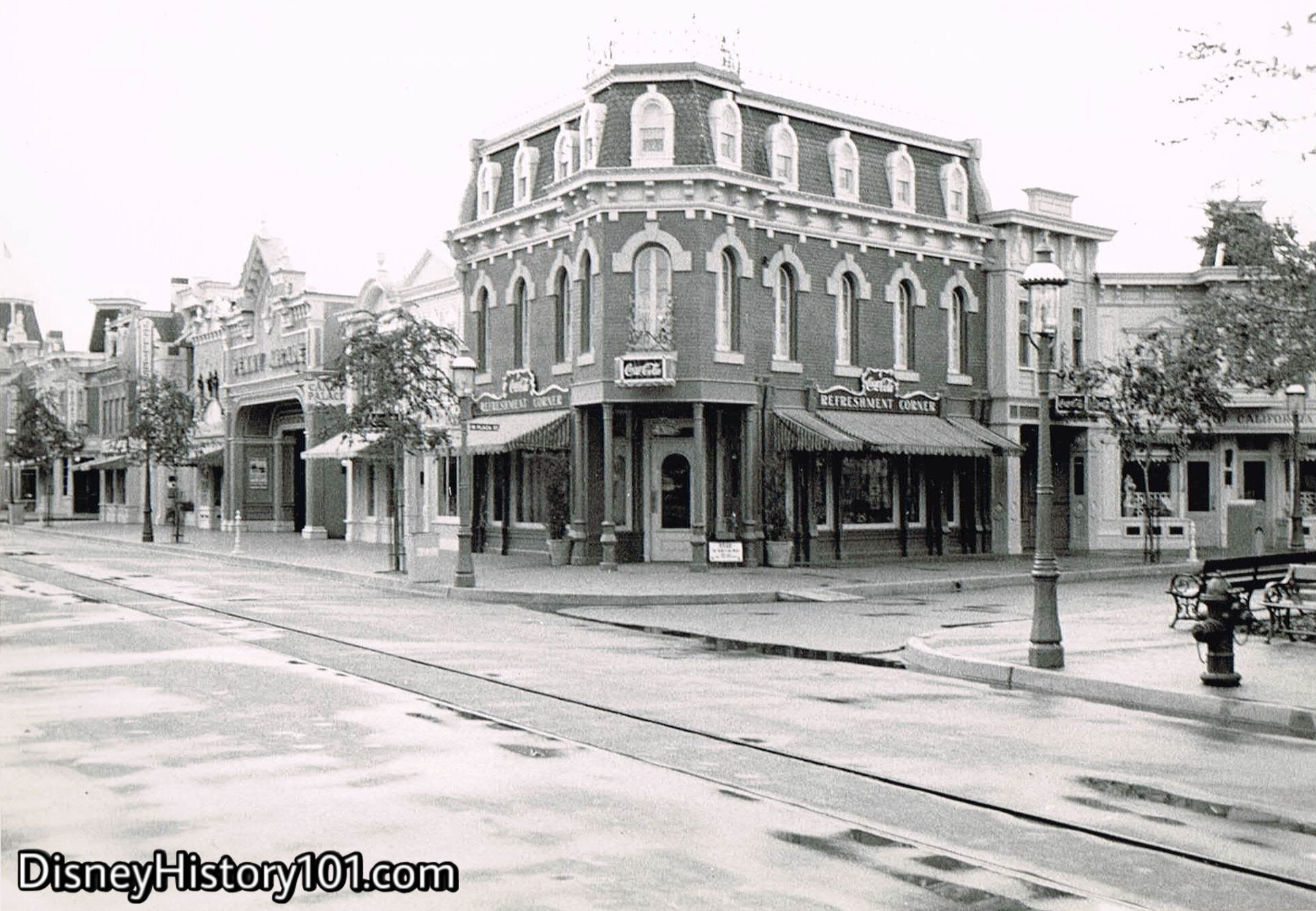
Coca-Cola Refreshment Corner Next Door to Cole of California (right), 1955.
“Stop at the Corner for a Coke…and a smile!”
UPT Concessions and Coca-Cola presented the Refreshment Corner. It was estimated that the Coca-Cola Refreshment Corner had the capacity to serve 600 guests per hour. With that forecast, the Coca-Cola Refreshment Corner was destined to become one of Disneyland’s eating facilities which was predicted to contribute to accommodating “15,000 persons daily, hitting a peak of 60,000 on holidays and week-ends…” and one of “twenty restaurants and snack bars, capable of saving 8,000 hourly,” at least according to “Building A Dream” (prepared by the Disneyland, Inc. Public Relations Department).
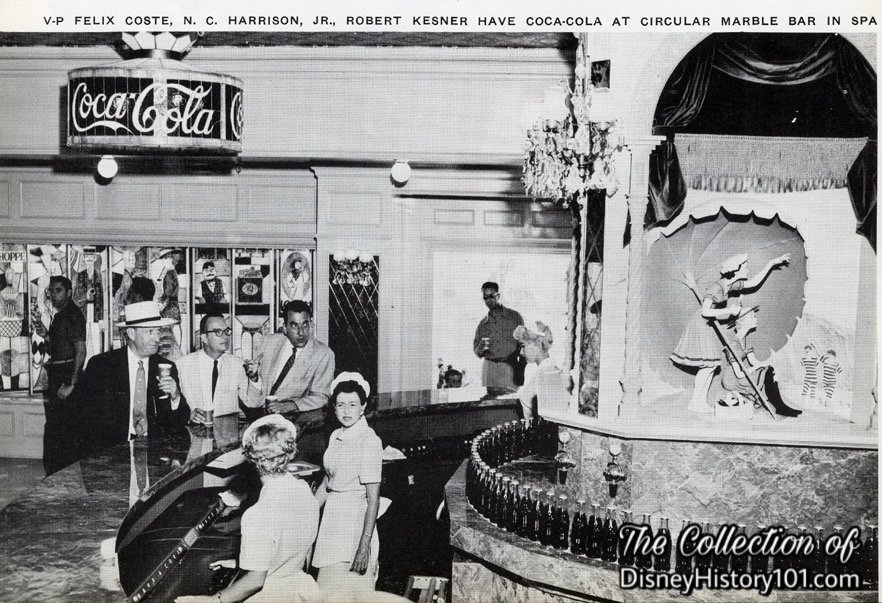
VP FELIX COSTE, N. C. HARRISON, JR., ROBERT KESNER enjoy King-sized bottles of Coca-Cola in an excerpt from The Refresher, September, 1955.
When the doors of this quick service restaurant opened for the first time, the menu initially only included Coca-Cola (originally served only in bottles). Here (overseen by Jim Baker of Disneyland, Inc.; under the management of Helen Case), guests could enjoy the “pause that refreshes,” at the Coca Cola Soft Drinks Parlor (as it was called in the c. 1955 “Your Guide to Disneyland”). Incidentally, cola sales at the Park were “astronomical” due to a recent plumbers strike and resultant non-operational drinking fountains. Helen’s daughter recollected : “I was only four years old. I remember hearing her talk about how busy they were, and they were serving right out of coke bottles. They would open two at a time to service customers. She really enjoyed it.”
Pre-mixed tanks were added to Coca-Corner during the next year (ending the situation where Guests would walk around with glass bottles). At that time, Coke was served without ice, as “the Coca-Cola Company wanted Guests top taste Coke at its full flavor, undiluted by ice.”
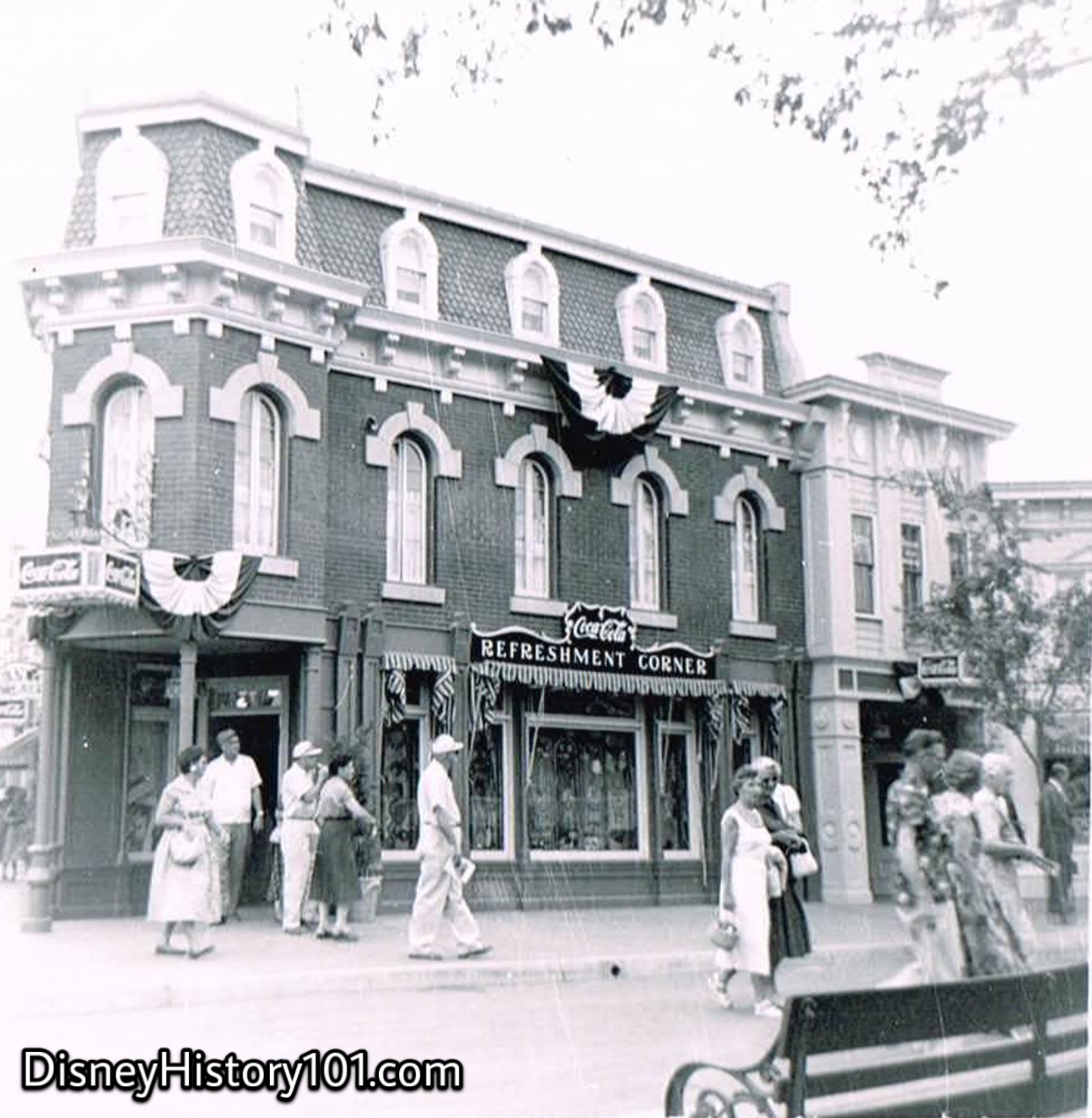
Coca-Cola Refreshment Corner Front of House, August 4th, 1955.
As Walt described to Bob Thomas (of Associated Press), “some industries will have exhibits, but all of them must be in keeping with the era.” Inside the dining room, was an exhibit (similar the Upjohn Pharmacy or the Wurlitzer Music Hall exhibits). According to Disneyland LINE (published for April 12, 1991), “Near two of the doors are replicas of antique thermometers, which were popular at the turn of the century. Commissioned by Coca-Cola especially for Disneyland, these thermometers were constructed by the Ohio Thermometer Company introduced to the Park in 1957.” Old-fashioned pictures and wire chairs added to the feeling of sitting in another era, while “dining in Disneyland.” Eight covers of THE REFRESHER, in full color, appeared in the Refreshment Corner's lifesize illuminated panel display. All of the entertainment occurred in the vicinity of three antique stained glass fixtures (valued at more than $5,000 each)!
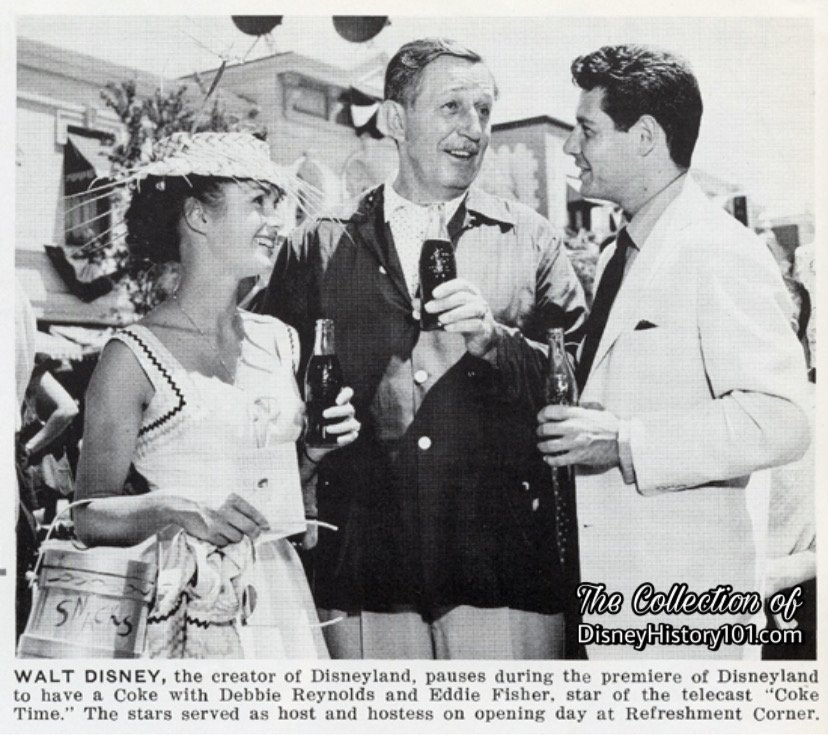
Eddie Fisher, Debbie Reynolds, and Walt enjoy a bottle of ice cold Coca-Cola in this Excerpt from The Refresher, September, 1955.
The Coca-Cola Refreshment Corner was also the only part of the Main Street Food Complex that offered guests continuous live entertainment while they enjoy their refreshments, either in the dining room or on the patio. According to Dave Smith (previous Chief Archivist Emeritus of the Walt Disney Archives), “In its early years, Disneyland did not have the atmosphere bands that are used today. In fact, in 1955 there was only the Disneyland Band and the small band in the Golden Horseshoe. The Firehouse Five Plus Two occasionally played, and there was a barbershop quartet and the Coke Corner pianist on Main Street, U.S.A.” [Disney Facts Revealed by Dave Smith, 2016] “When the Refreshment Corner opened with the Park in 1955…Eddie Fisher was the star of ‘The Coca-Cola Hour’, a musical variety show, and was on hand opening day with his fiancé, Debbie Reynolds.” That day, the duo was photographed pausing for a Coke with both Walt Disney and the Tomorrowland Spaceman. Both Eddie Fisher and Debbie Reynolds returned to Disneyland and signed autographs for fans, the very next day.
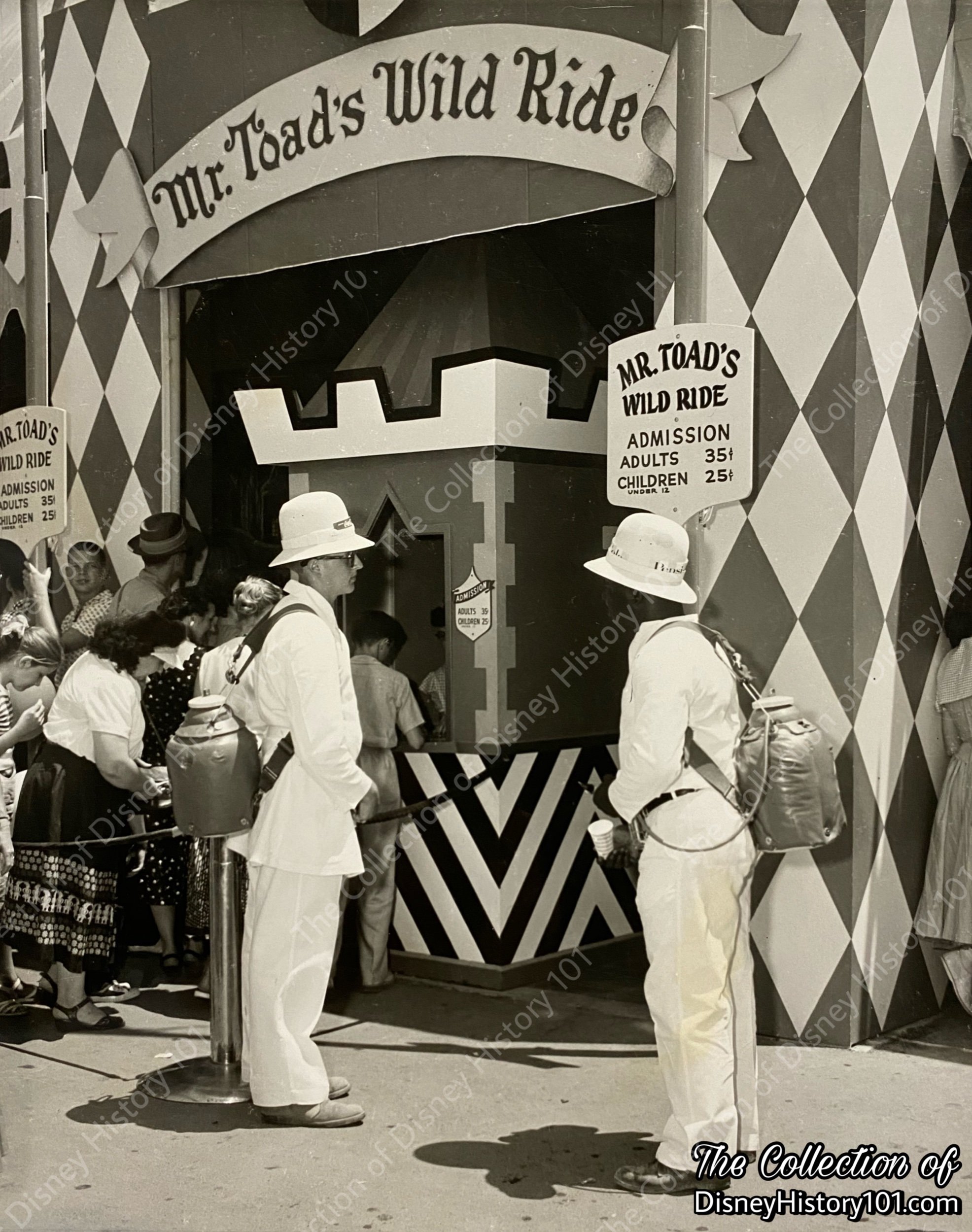
Coca-Cola Vendor and Pepsi-Cola Vendor near Mr. Toad’s Wild Ride; ©️ Walt Disney Productions.
On December 10, 1955 Coca Cola bottling Co. of Santa Ana provided beverages for the First Annual Christmas Party.
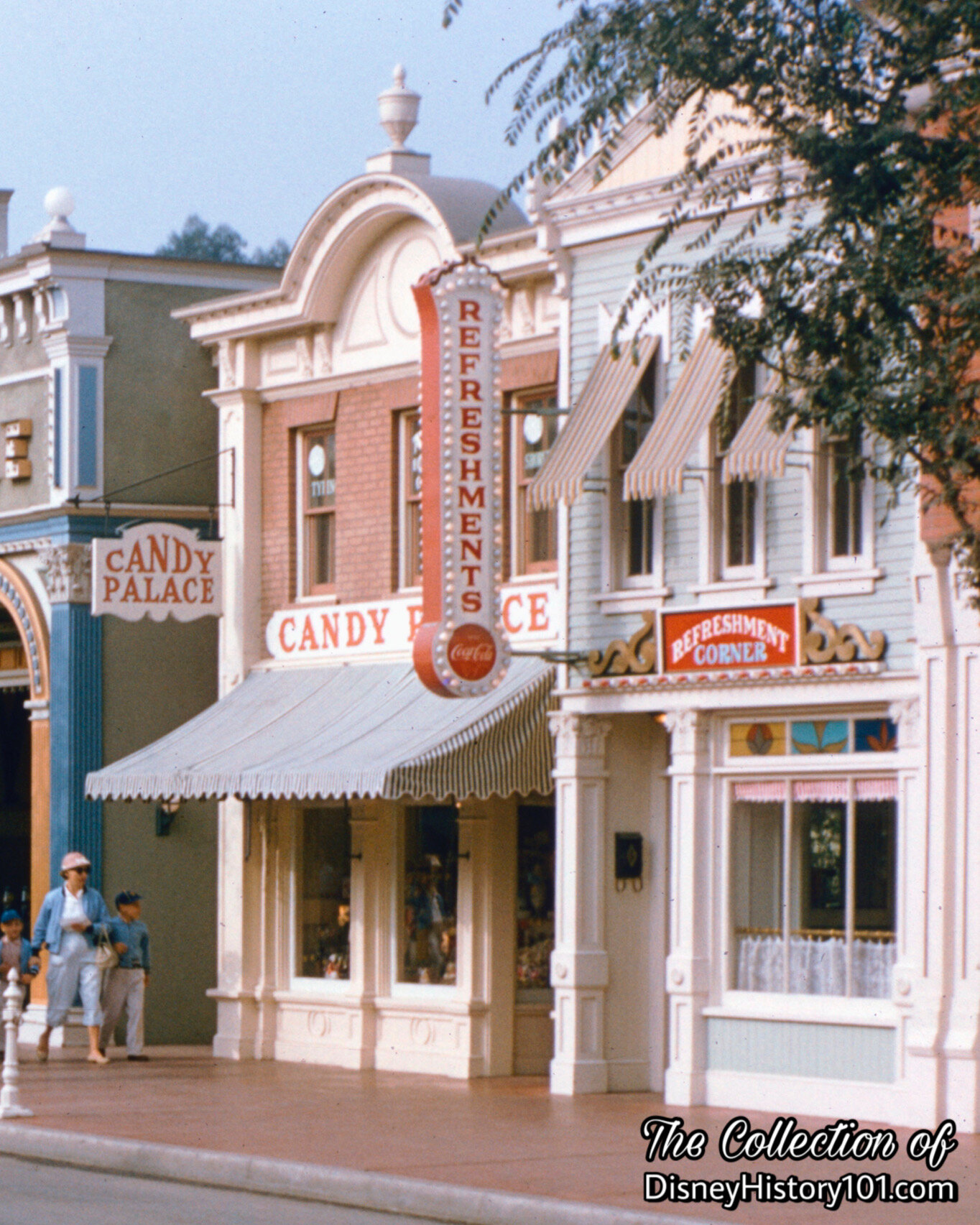
Coca-Cola Refreshment Corner Architectural Facade, Main Street
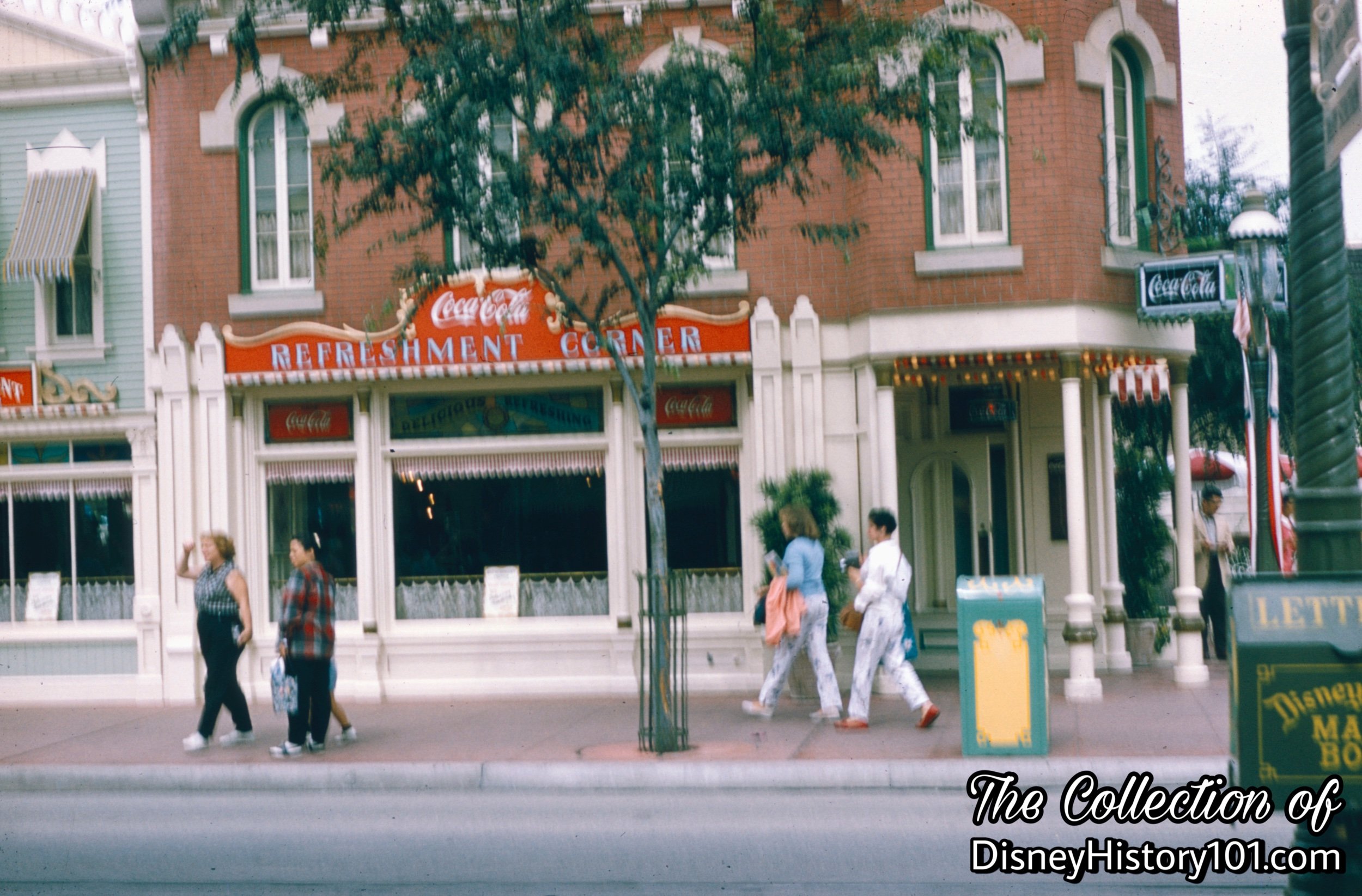
Coca-Cola Refreshment Corner Architectural Facade, Main Street, 1958.
Beyond creating happiness, the Participant sponsored exhibit and leased space would provide a certain amount of income to Disneyland Inc., contributing toward the construction and growth of Disneyland. Why in 1958, Bank of America appraisers figured of the total income received from leases, 16.02% was derived from the selling of advertising rights and 40.12% from the leasing of space to concerns whose main reason for occupancy is for advertising purposes. The remaining 43.86% of the lease income was derived from stores that sell various products and food (like Coca-Cola Refreshment Corner).
By September of 1958, spaces occupied by the lessee included the exterior 312 square-foot Coca-Cola Side Walk Cafe (similar to the contemporaneous 216 square-foot Carnation Side Walk Cafe). Institutional lessee The Coca-Cola Company yielded some revenue for Disneyland Inc. - $22,825 for the fiscal year ending September 29, 1957 and $25,660 for the fiscal year ending September 28, 1958. By September of 1958, the Coca-Cola Company was still contributing a routine portion of accounts receivable to Disneyland, Inc. By 1959, the company was one of about 65 companies who used the park to publicize their wares, leased space in the Park to sell their wares, and from whom Disneyland collected advertising fees.
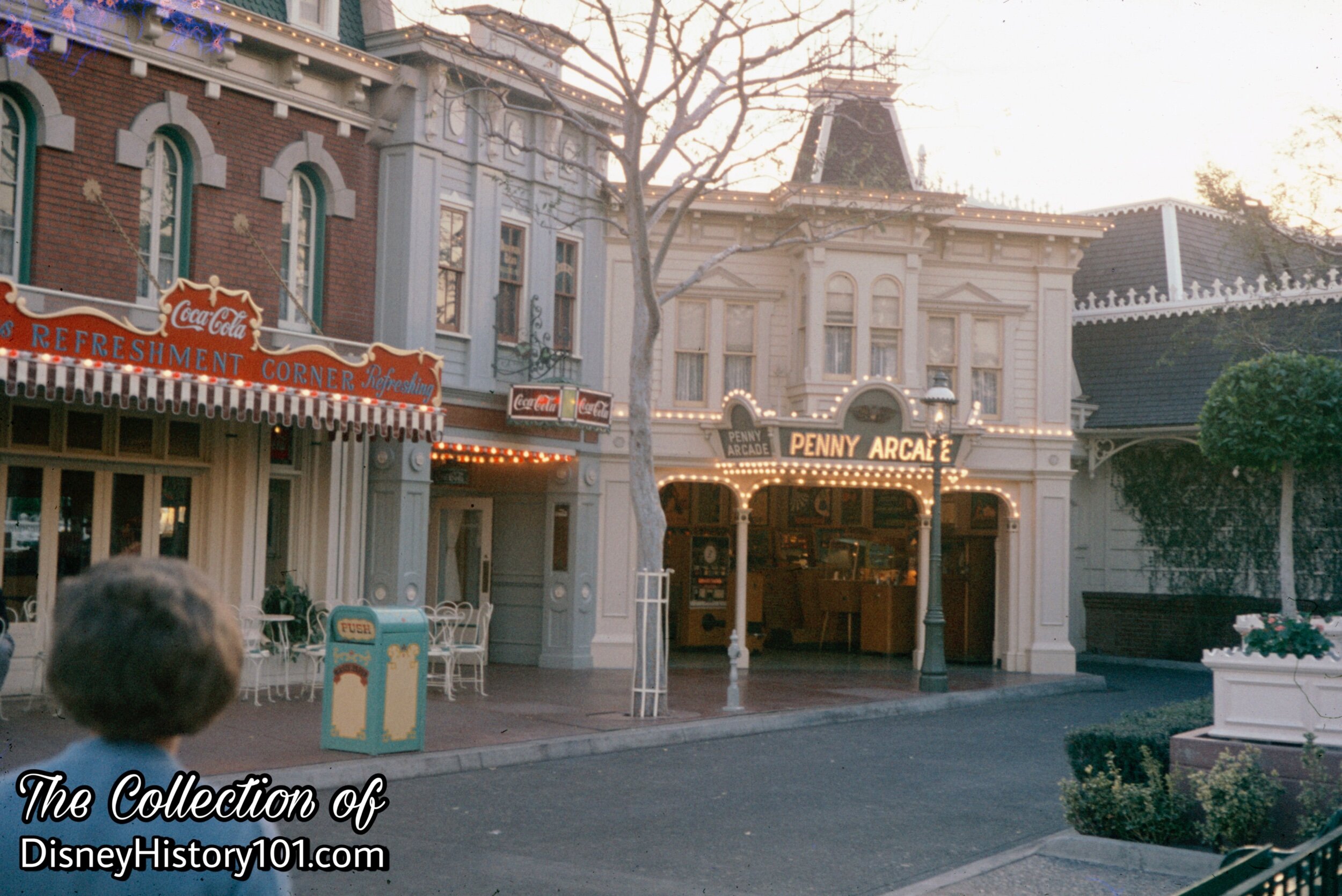
Coca-Cola Refreshment Corner West Plaza Entrance Architectural Facade
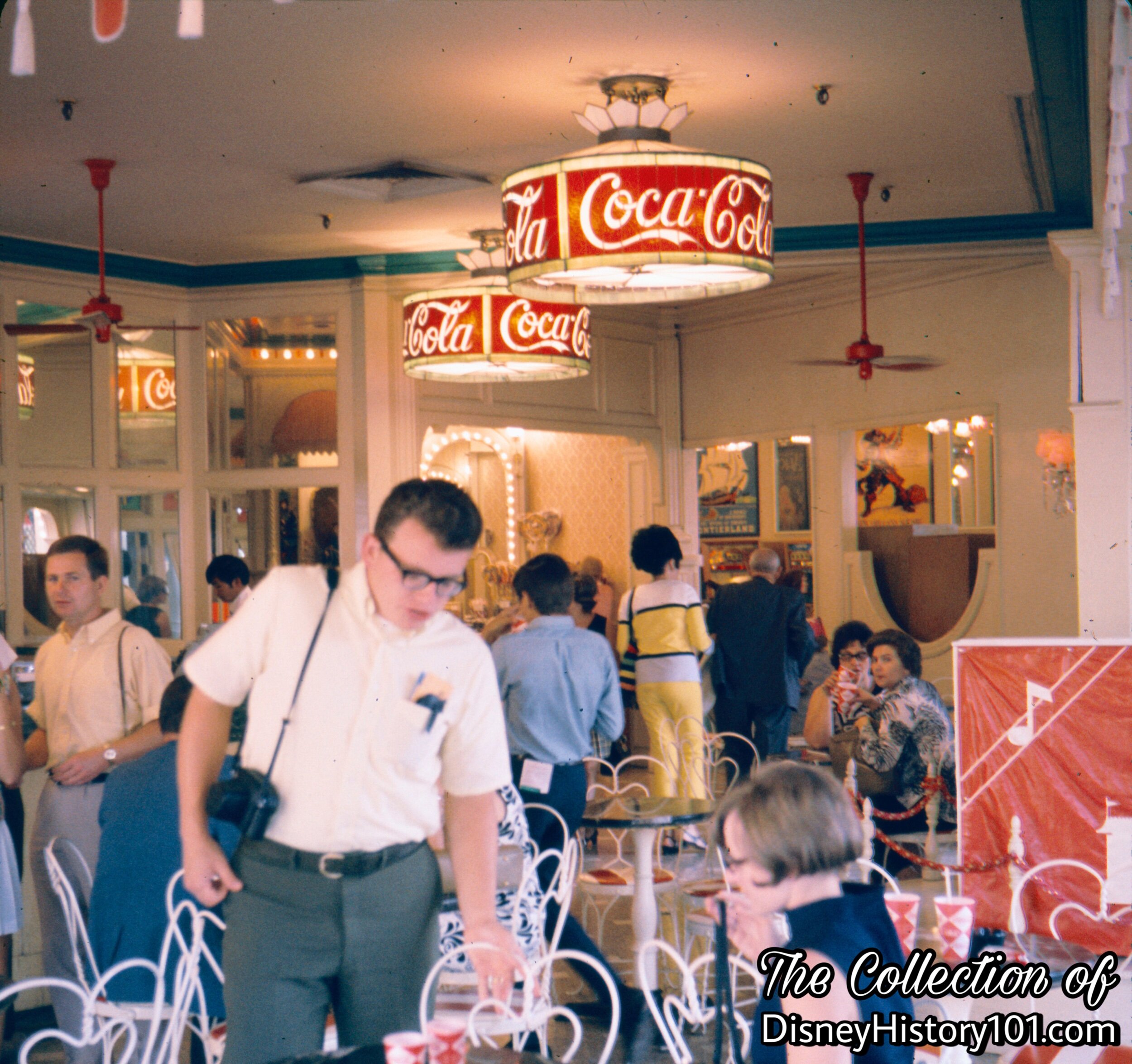
Coca-Cola Refreshment Corner, (September, 1969)
“Things Go Better With A Coke”
Now, its been said that “Coca-Cola makes good things taste better.” So eventually, (by 1958), the restaurant served pre-mixed Coca Cola and king-sized bottled Coke, and sandwiches. Soon, the Coca-Cola Refreshment Corner menu included hot dogs, cold sandwiches (as tuna, and ham & cheese), peanut butter and jelly sandwiches, chips, and even dessert options (as apple turnovers and brownies).
As a sidelight, by October 1959, Jim Baker (of Merchandising) was overseeing the Disneyland Food Administration and Souvenir Sales. By October of 1959, the company was (1) of over sixty-eight other firms playing a vital part in the team effort to bring happiness to Disneyland’s Guests. Some were small, specialized individual operators; some were huge companies such as Swift & Co. - the Bank of America - United Paramount Theaters (which you hear as UPT) - Carnation - Richfield - General Dynamics - Crane - and many others. These companies used the park to publicize their wares, leased space in the Park to sell their wares, and Disneyland collected advertising fees from them.
During the late 1960s, the “walk-away” restaurant (under the management of Max Sloan) still offered an assortment of beverages and light snacks for “people on the go.” Still, their most popular item was Coca-Cola. In fact, the crew once served “more than 350 gallons of Coke on a busy day,” according to Disneyland Line, September 27, 1979.
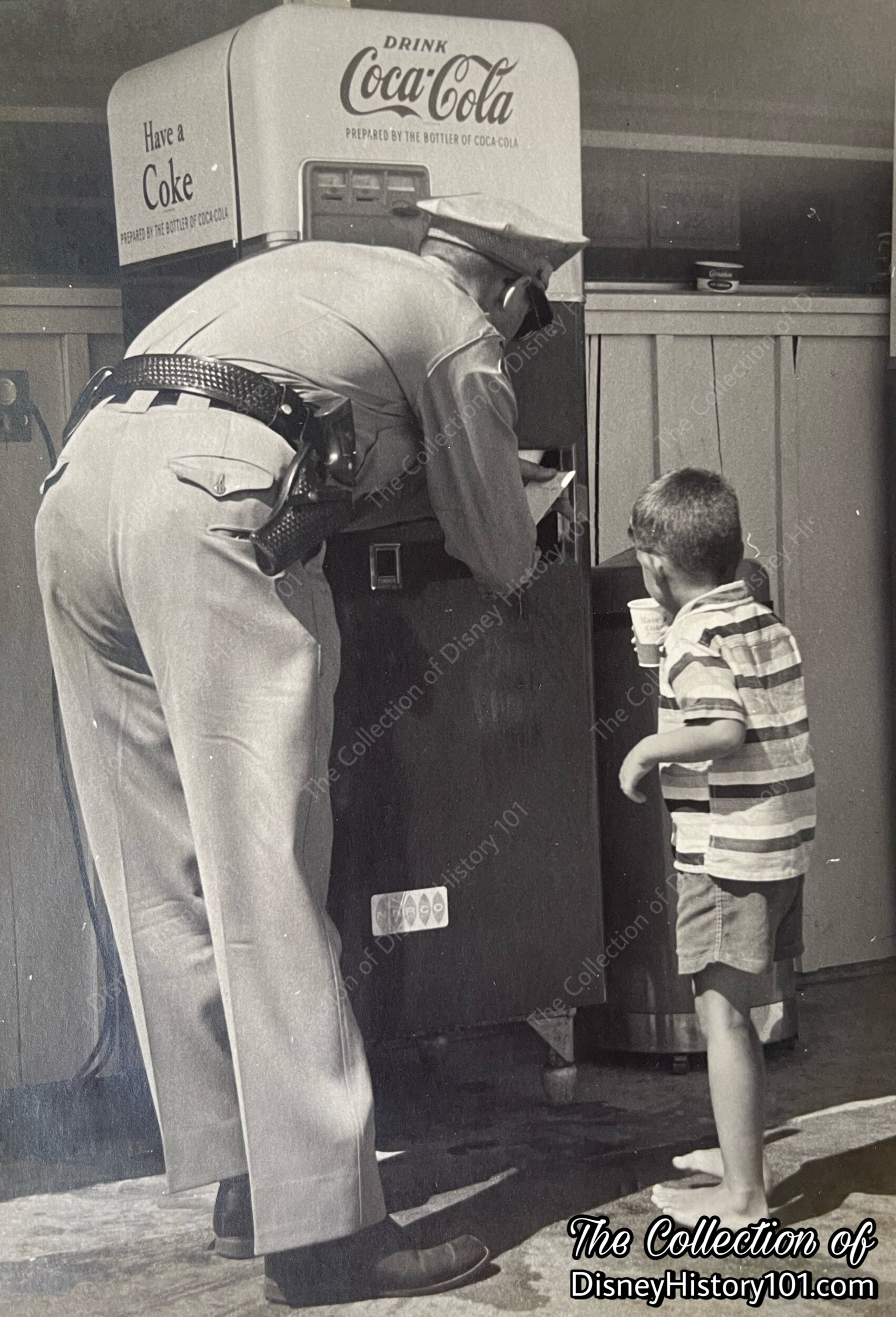
A Dixie-Narco Coca-Cola Vending Machine at a Holidayland Kiosk
The Holidayland Picnic Area at Disneyland featured several kiosks and the Holidayland Snack Bar (managed by Myrt Westering of the Red Wagon Company). Myrt Westering, promised that “the facilities will be as modern and as up to date as modern food science can make them…… it is so arranged that the hot dogs will be HOT and the cold drinks will be COLD.” [“Disneylander,” May, 1957]. As aforementioned, bottles of Ice Cold Coca-Cola were available to Disneyland (and Holidayland) audiences. But after about a year, the Disneyland Operations team decided to do away with Disneyland carrying bottles. Pre-mixed tanks were added to Coca-Corner and Coke was served without ice, as “the Coca-Cola Company wanted Guests top taste Coke at its full flavor, undiluted by ice.” Once Holidayland opened, Guests enjoying a picnic could enjoy cups of ice-cold Coca-Cola through an arrangement with Dixie-Narco (manufacturer of contemporaneous Disneyland Dixie paper cups).
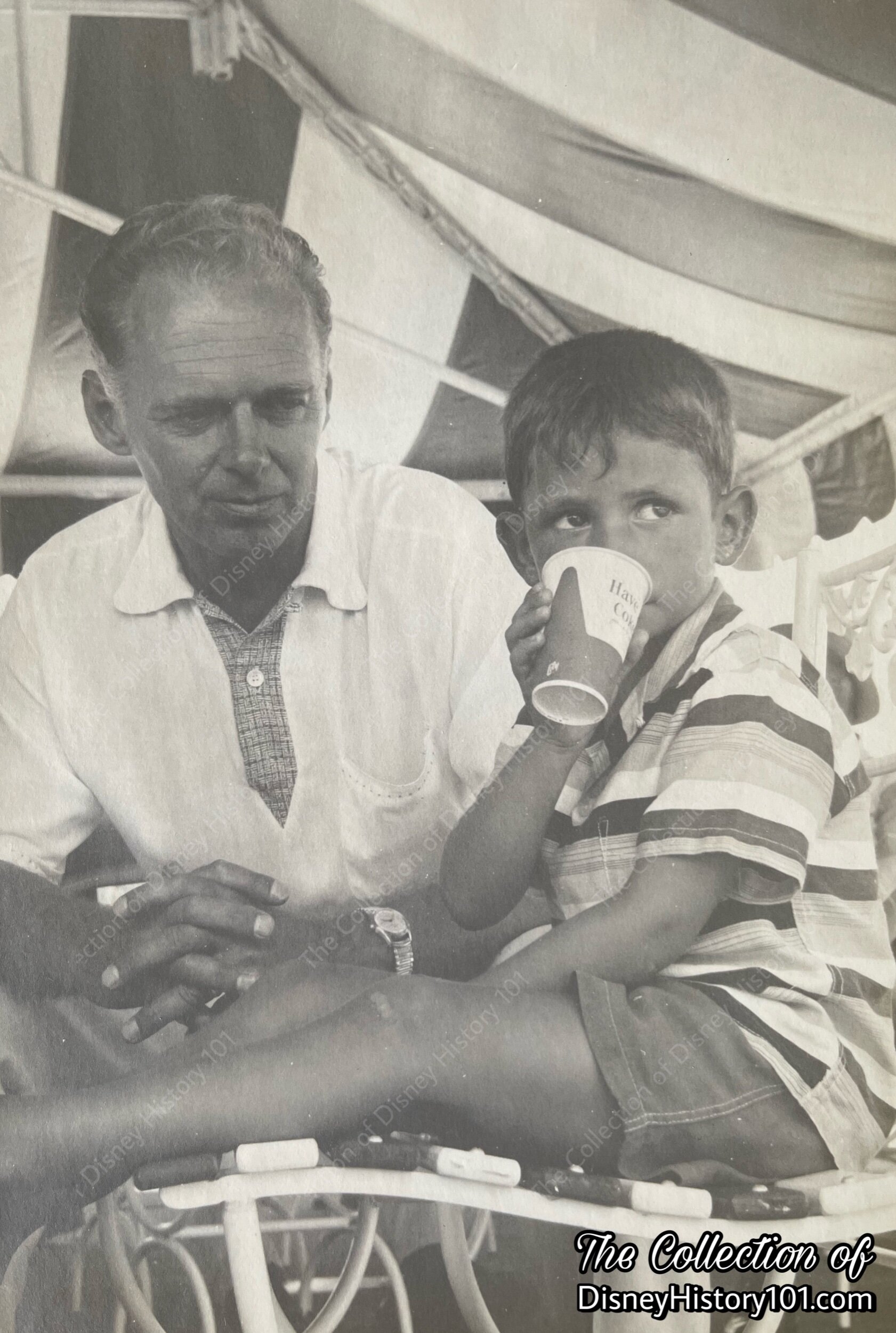
A Young Guest enjoys a Coke at Holidayland
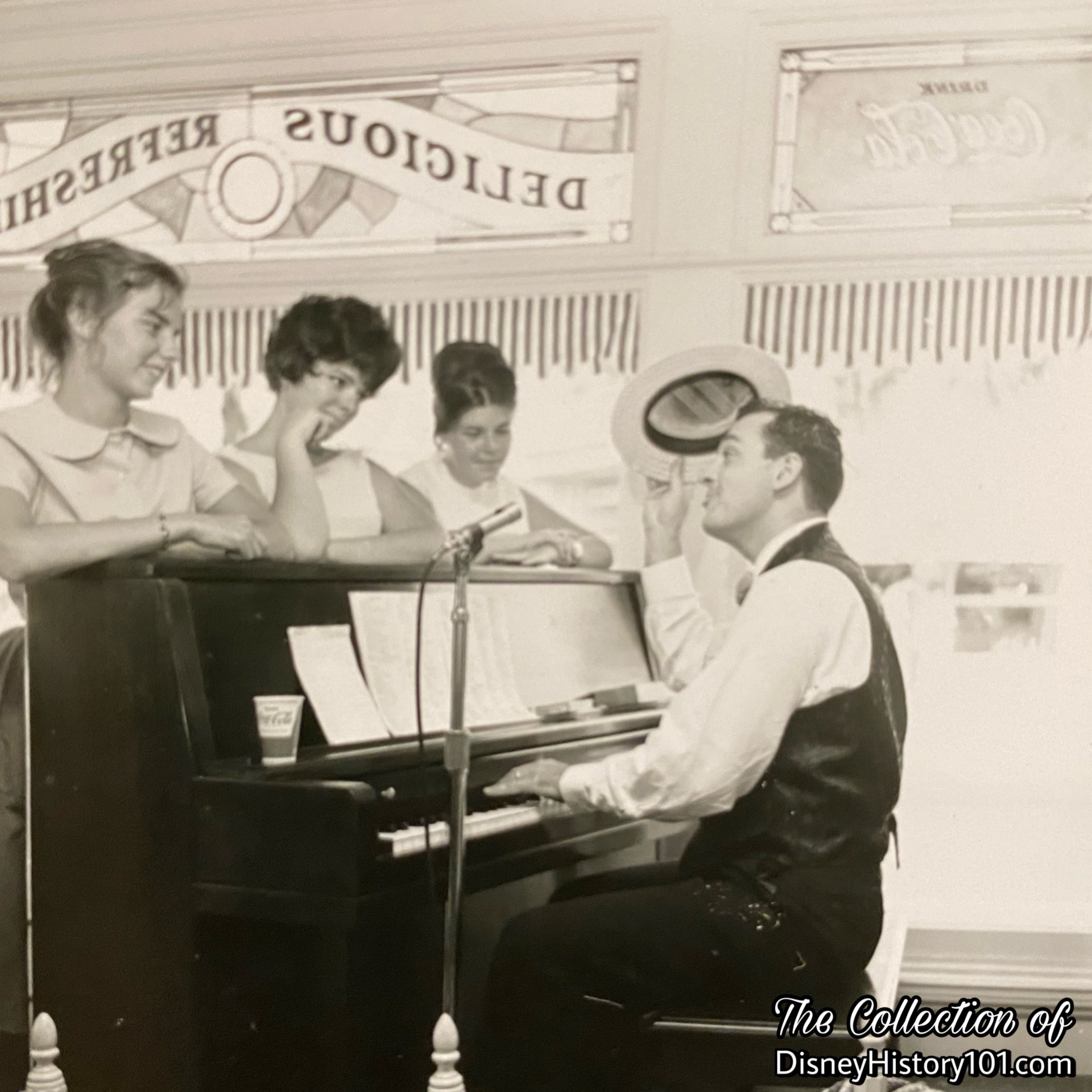
Coke Corner provided the setting for all sorts of entertainment, events, and promotions. The restaurant was temporarily utilized for Grad Nite Photo Locations and Grad Nite musicians who provided entertainment pleasure for guests. For example, David Rakes performed here during Grad Nite of 1962, bills advertise some unnamed “Folk Singer” for Grad Nite of 1963, and Denny Brooks played here during Grad Nite of 1964. The Varsity Duo was a regular act during the summer of 1968. A promotion during 1963, offered Coca-Cola customers the opportunity to open a bottle and “take Disneyland home with them” in the form of 18 miniature licensed character figures.
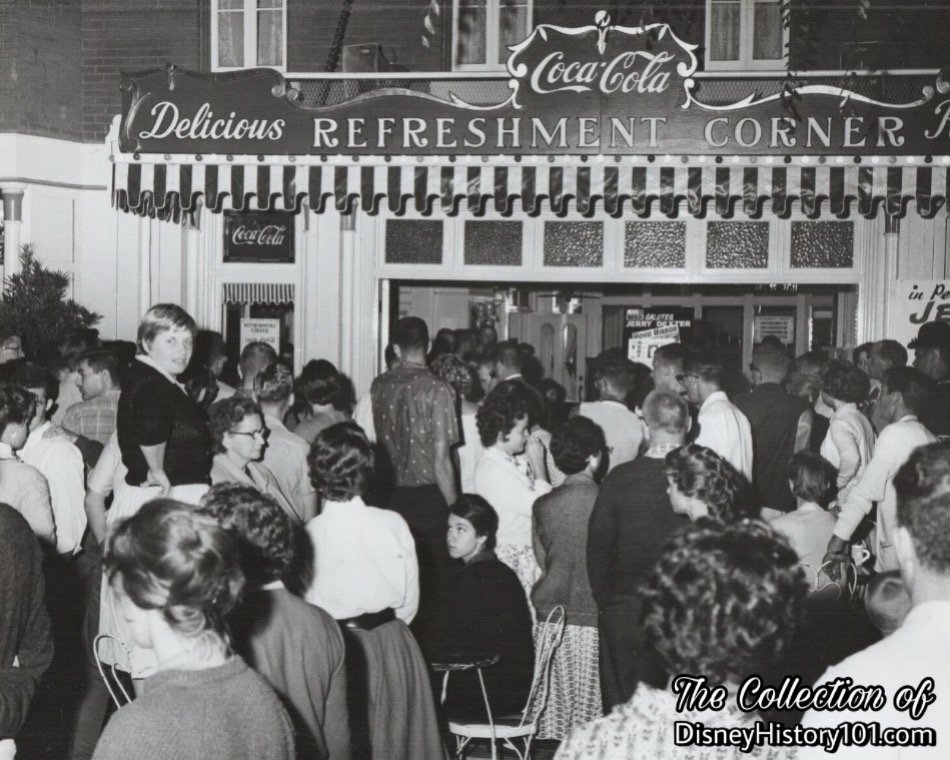
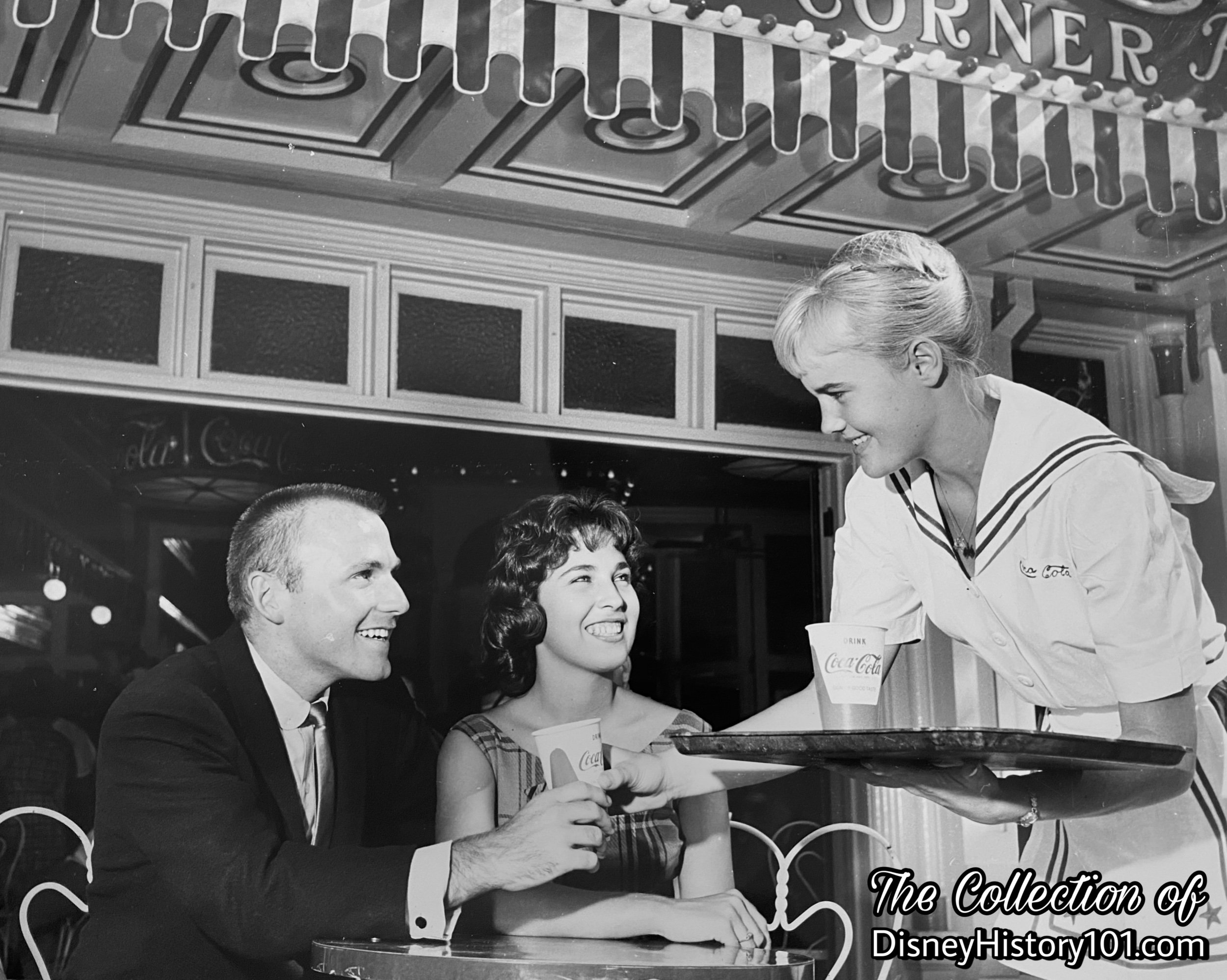
A Hostess extends courtesy to KMPC DJ Jerry Dexter at the Coca-Cola Refreshment Corner, in “the Happiest Place on Earth.”
By January of 1958, the lessee also occupied the 312 square-foot exterior area known as Coca Cola Side Walk Cafe. During 1960, KMPC DJ Jerry Dexter hosted the program nightly on radio station KMPC - 710 on everybody’s dial, from 10 until midnight. Jerry also hosted the program live from Disneyland every Friday and Saturday night. In promotion, a Coca-Cola Refreshment Corner lessee Hostess Disneylander displays Disney Courtesy with a smile while serving Coca-Cola to KMPC DJ Jerry Dexter and another guest.
By 1960, Disneyland wasn’t the only theme park with a Coca-Cola Company sponsored exhibit. Freedomland had a Coca-Cola Company sponsored by Hospitality Area.
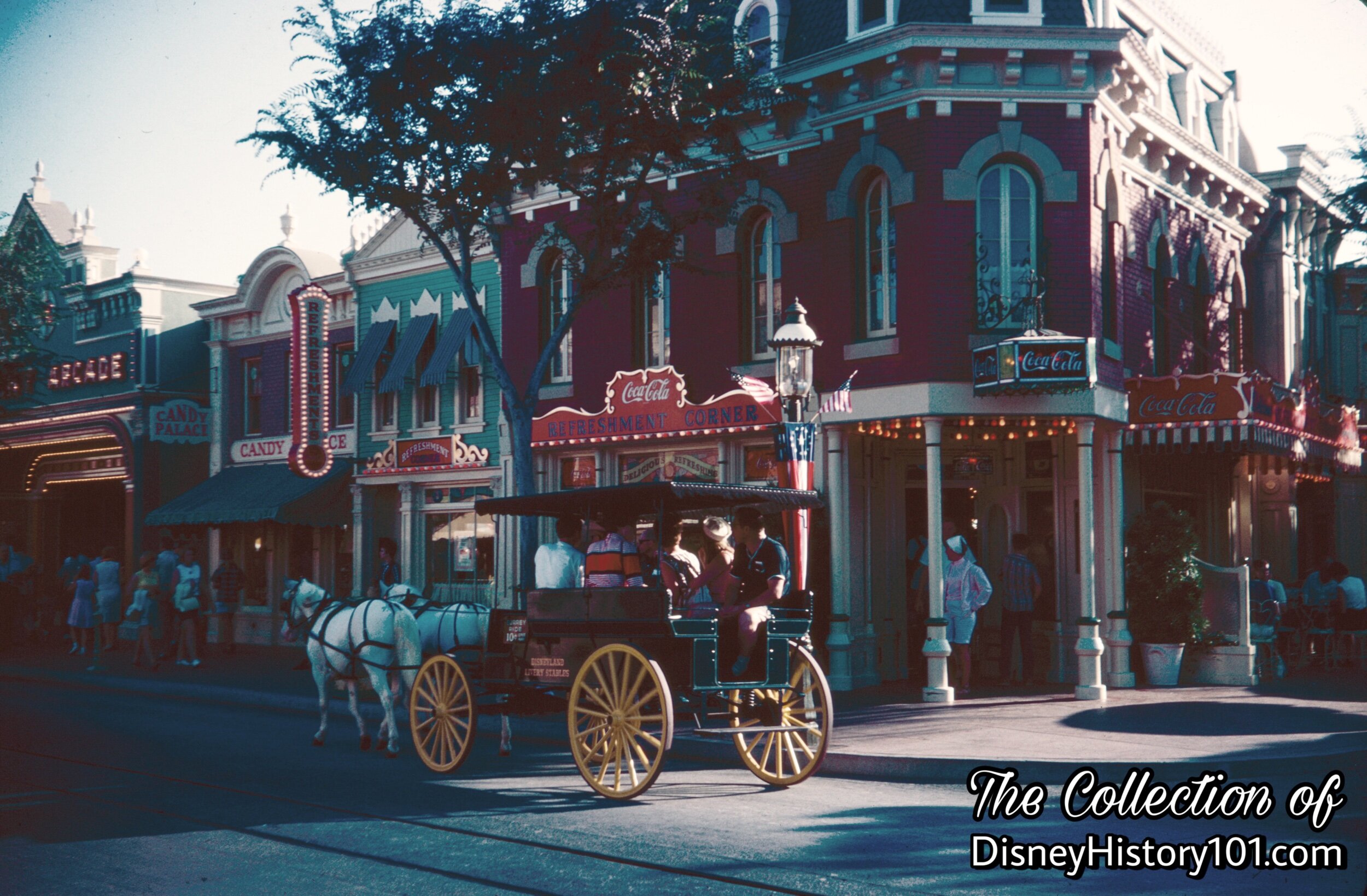
Coca Cola Refreshment Corner, (1966)
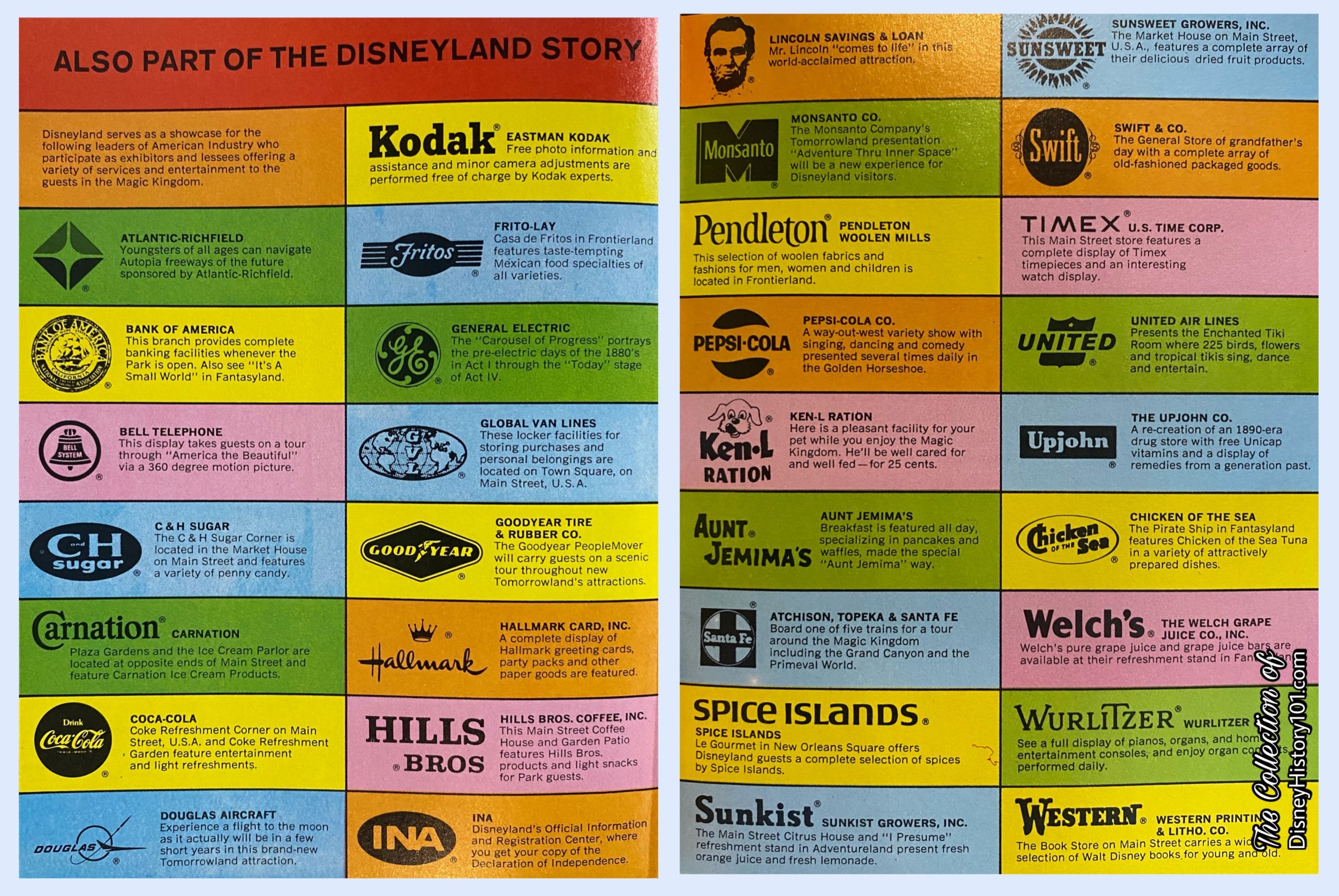
Coca-Cola was a Disneyland Participant and thus “part of the Disneyland story according to this “Disneyland ‘67” Excerpt.

"'RAGTIME' ROBERT GLENN : FROM SOLO SYMPHONIES TO FOUR-HANDED FANTASIA"
Music, as a basic ingredient of showman-ship, covers the Park. According to “THE DISNEY THEME SHOW - an introduction to the art of Disney outdoor entertainment”: “Important are the sounds which permeate the scene, for without them, the theme show is a silent movie . . . but with them it is a symphony of music, effects, and natural sounds that the finest stereo system in the world can't duplicate. These sights and sounds are provided not only by imagineered attractions and shows, but also through the multi-talented efforts of live entertainers . . . in special musical groups . . . in parades and pageants . . . providing an everchanging backdrop to virtually every area in the theme show.”
A variety of live shows entertained Guests throughout the day. Guests were encouraged to “gather ‘round the upright piano” for their favorite syncopated ragtime melodies, while honky Tonk daytime pianists exemplified the spirit of Disneyland, entertaining guests. For instance, during the winter season of 1967 (December 16th, 1967 thru January 1st, 1968), Rudy Pena played piano and sang melodies from “‘the good ol’ days’ in a fresh new spirit.” This Atmosphere Entertainment occurred “throughout the Christmas Holidays” (seven shows daily, between parades, from 10:00am to 5:00pm, except Mondays). [“Disneyland Holiday Talent Master Schedule,” prepared for the period of December 16, 1967 through January 1, 1968]
By November 26, 1972 through May 26, 1973, the Coke Corner pianist performed daily from 10:00 AM - 5:00 PM (Off Mon. & Tues.); 12:00 Noon to 7:00 PM on Sunday, and at Mix-in Parties. The Coke Corner Piano Player Sub performed 2 days a week.
“Honky-Tonkin’”
Perhaps one of the most famous of these talented pianist-singer extraordinaires is Rod Miller (who had a 36-year career, from 1969 to 2005). You may also remember nighttime pianist Judy Carmichael, or Ray Templan (who filled in during days off and vacations) would “tickle the ivories” and delight the audience with the sound of Ragtime! During the following decades, Johnny Hodges helped carry on the “four-handed” (and “five-handed”) piano legacy, from 1981 to 2006. “Ragtime” Robert was one notable pianist trained by the hands of the legendary Disneyland pianist Rod Miller! Robert would continue to carry the rhythm at Coca-Cola Refreshment Corner for a decade! You may listen to his story “From Solo Symphonies to Fourhanded Fantasia,” a Disney History 101 People Featurette, through the link above.
By 1969, the piano was 1 of 15 old-time band organs and pianos at Disneyland, some of which dated back to 1890. There just weren’t any replacement parts for these rare antiques. So, ARCADE MAINTENANCE performed the necessary versatile, creative, and inventive mechanical repairs. The Coca-Cola Refreshment Corner Piano was auctioned through “Celebrating 50 Years of Magical Memories” of Disneyland.
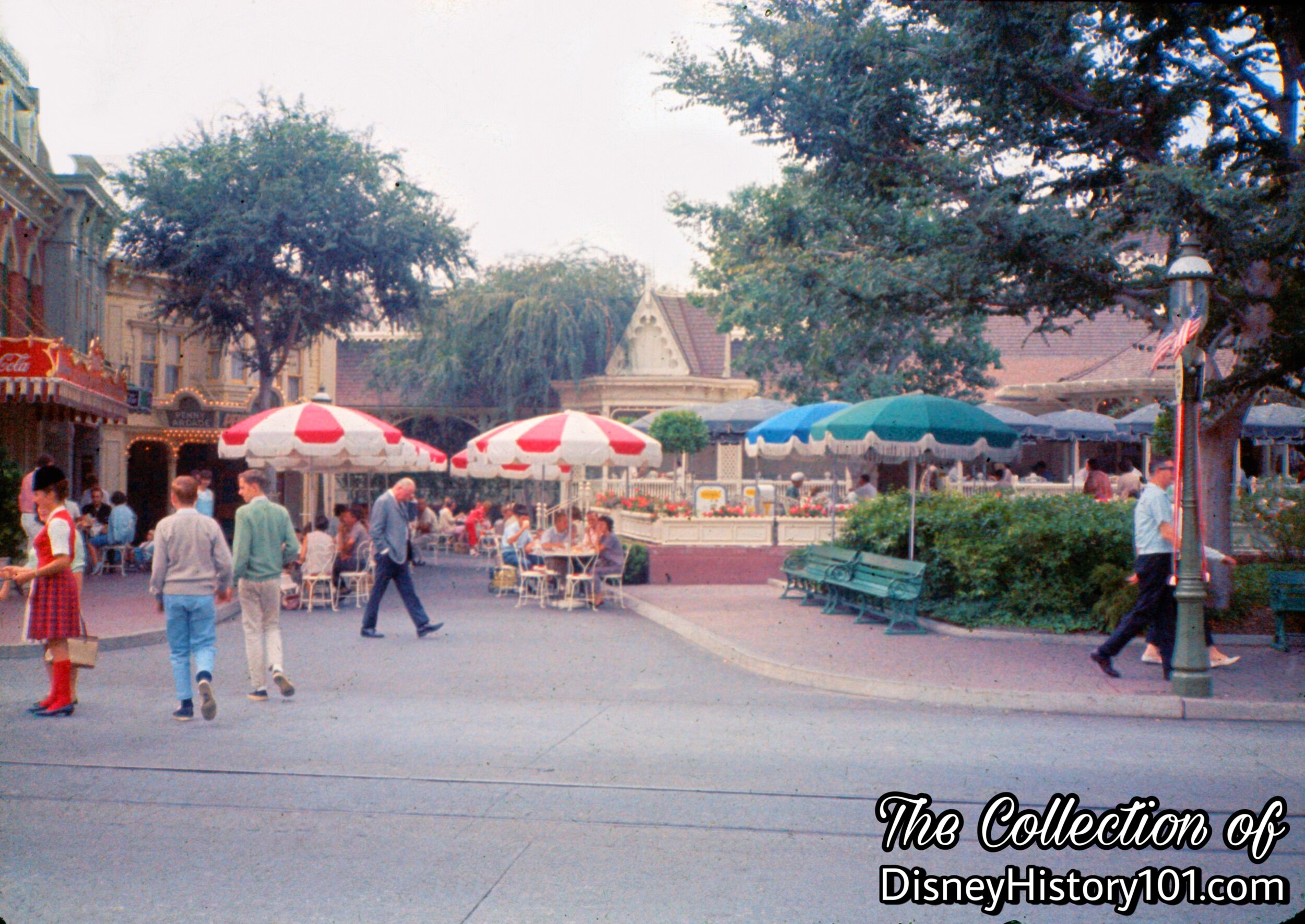
Coca-Cola Refreshment Corner Tables
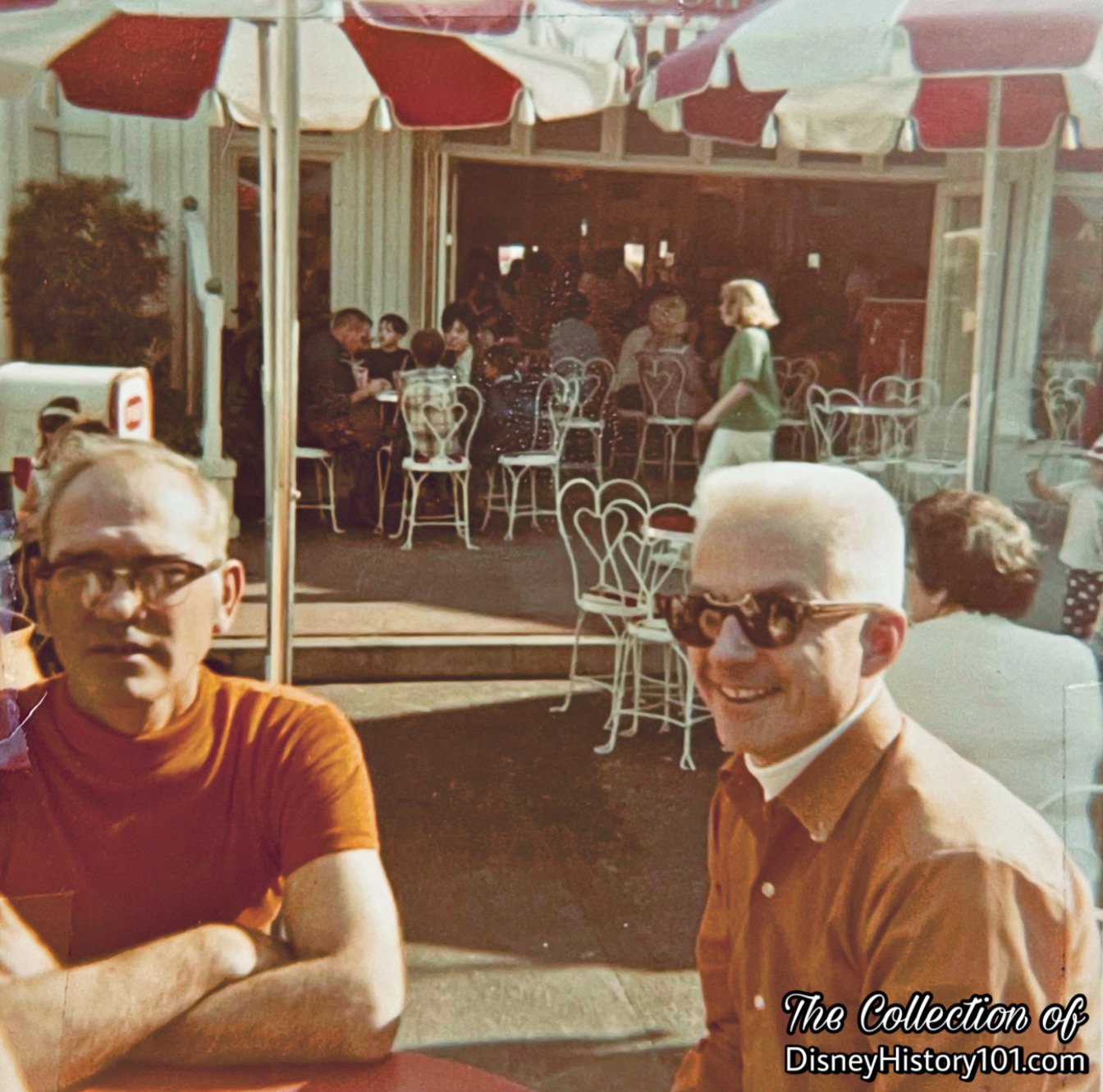
Guests Arden and Ken dining at Coca-Cola Refreshment Corner, Main Street, 1970.
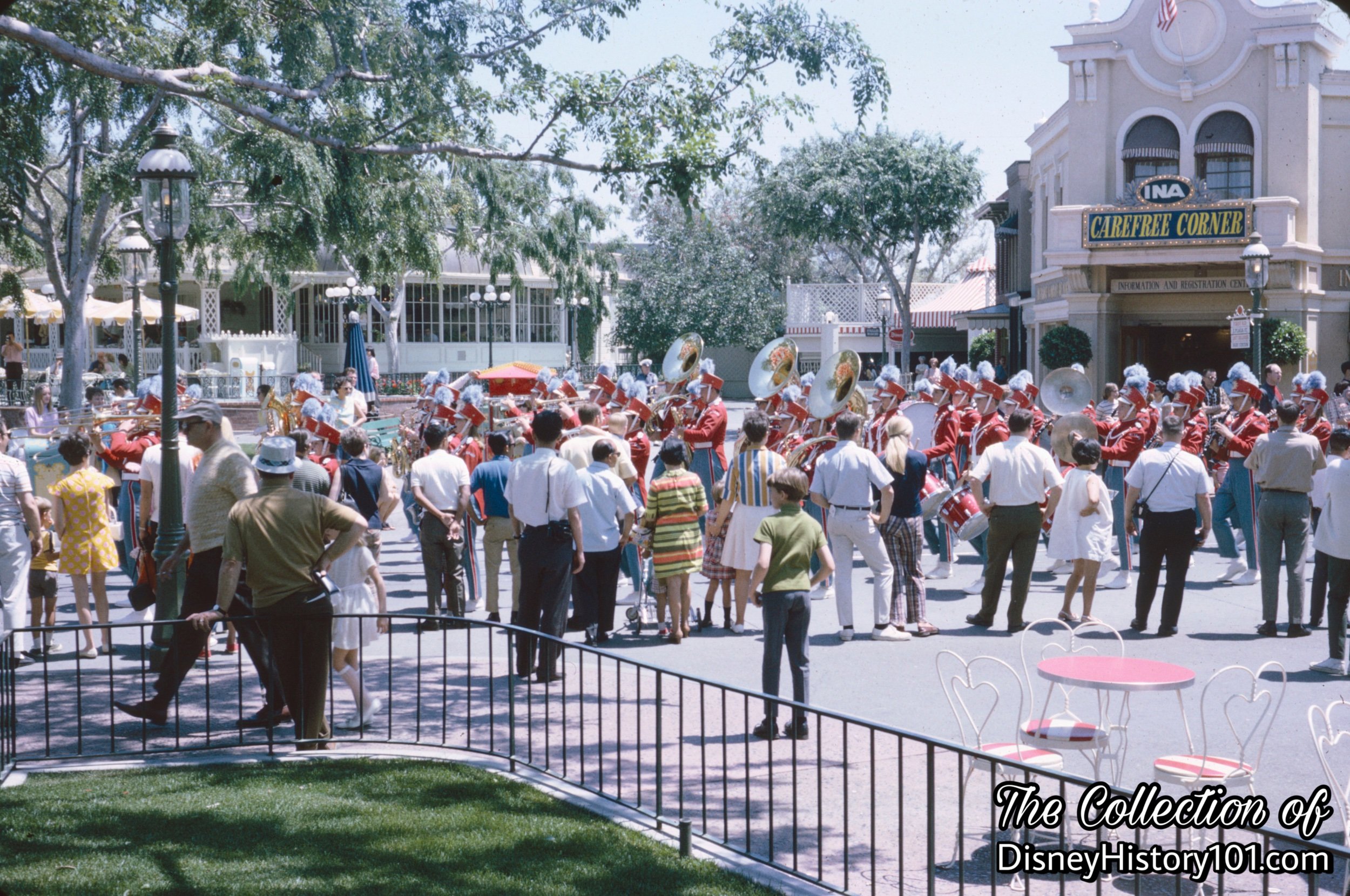
The view from Coca-Cola Refreshment Corner, Main Street
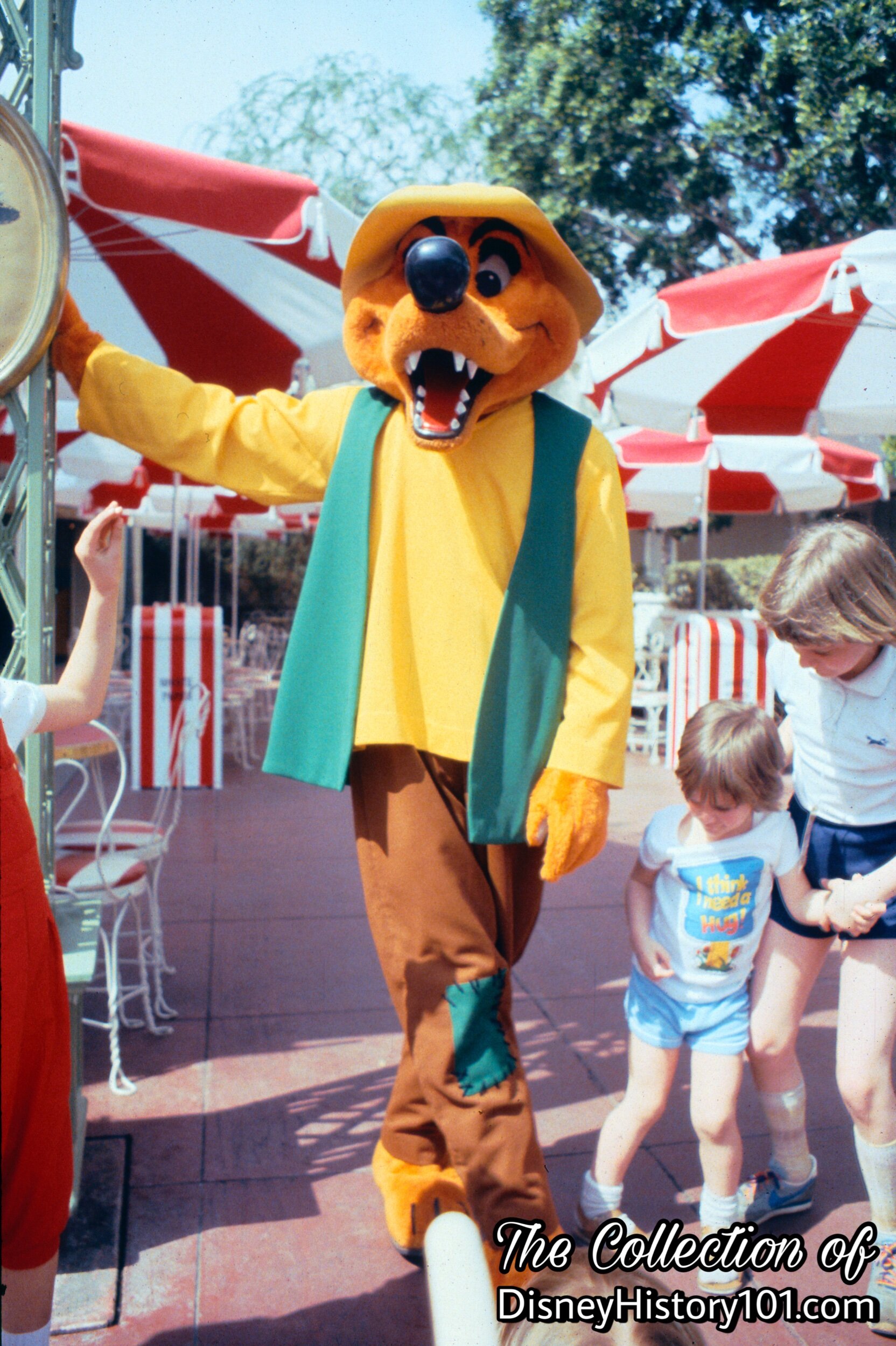
Br’er Fox greets Disneyland VIPs at Coca-Cola Refreshment Corner, March, 1962.

Goofy at Coca-Cola Refreshment Corner
Coca-Cola Refreshment Corner became a popular place to meet up with friends!
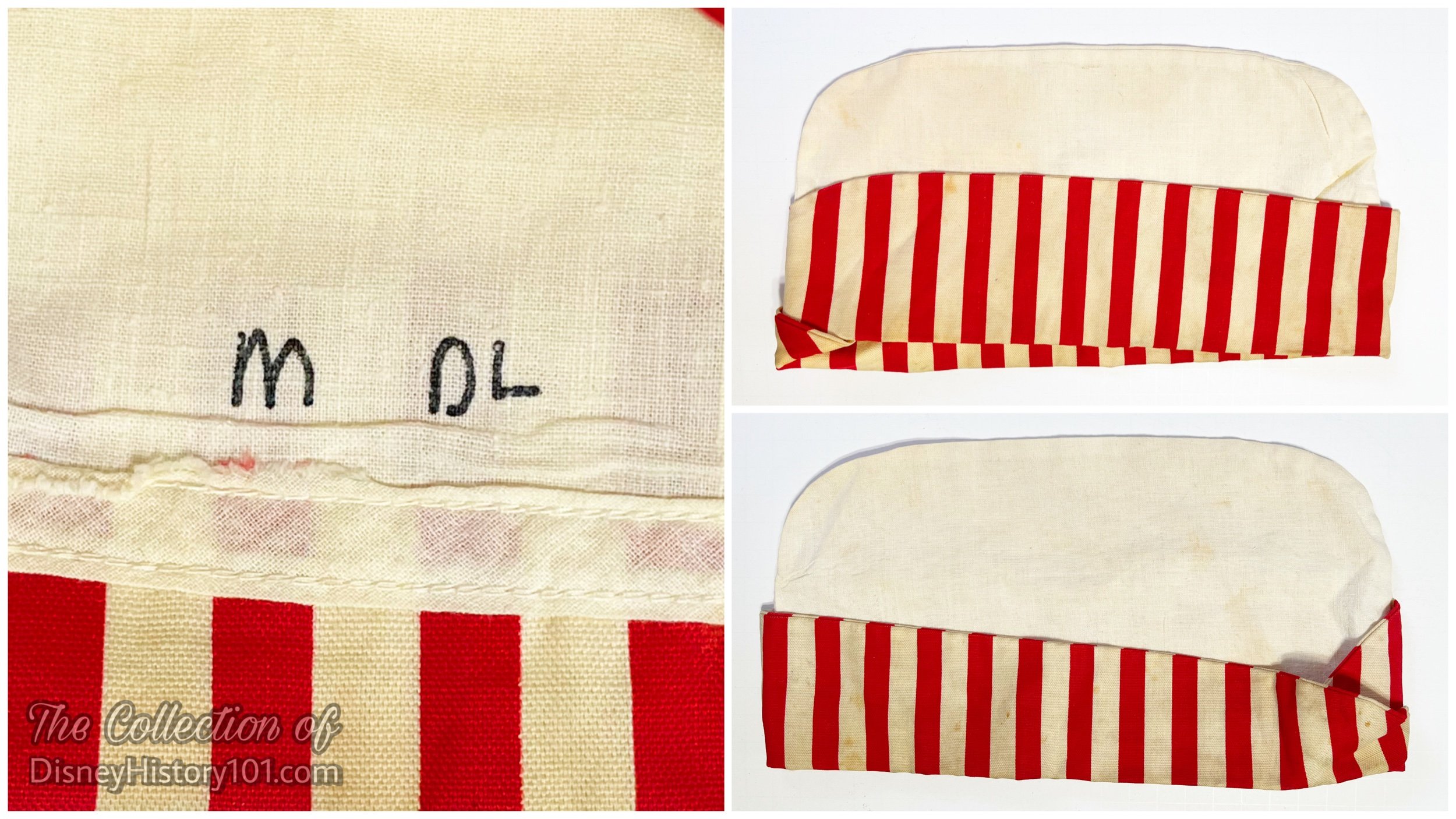
Coca-Cola Refreshment Corner Concessions Costume Hat, (c. 1970s)
The Disneyland Food Division took over operation (in January of 1966), but the Coca-Cola Company eventually continued its Participation with Disney Parks. The location had some of the more than 160 soda fountain heads at Disneyland that delivered 10,000 gallons of various soft drinks to thirsty guests.
During December of 1980, film crews, production vehicles, and huge fans descended on Main Street U.S.A., as a (Coca-Cola-produced) television commercial was filmed at Disneyland. The commercial featured 115 international children and adults (representing “virtually all the nations of the world”)! A mixture of a shaved block ice, carbonic foam, and styrofoam simulated falling snowflakes over the Coca Cola Refreshment Corner on Main Street U.S.A., to the tune of “I’d like to teach the world to sing.”
During January 2 to 21, 1973 Coke Corner was closed for a 3-week rehabilitation.
About that time, the Coca-Cola Refreshment Corner menu remained rather simple, consisting of the Superdog, Hot Dog, Chili & Beans (served during cold periods), chips (Fritos, Doritos, Cheetos, and potato chips), soft drinks (Coca-Cola, Sprite, and Fresca), milk, and desserts (turnovers and brownies).
In 1981, the Coca-Cola Refreshment Corner with its soda shop atmosphere, refreshments, hot dogs and brownies produced $1,320,000 in revenue for Main Street Food. This was owning to VIPs of Disneyland (guests), its Main Street Foods hosts and hostesses (totaling 176 summer/118 fall), two Main Street Foods Stage Supervisors, and Main Street Foods Area Stage Supervisor.
On August 10, 1982, the Coca Cola Company also provided soft drinks to the Burbank Hangar 5 Production Crew who were producing films for the Horizons Pavilion at EPCOT Center. The company donated the beverage dispensor for the duration of the Hangar Rental; and also the first 1000 soft drinks. This agreement was instrumental in obtaining the Disney World Wide Beverage Account Contract for Coca Cola. This contract went into effect on October 1, 1982, and gave Coca Cola sole rights to distribute soft drinks to all Disney projects, both present and future. The Coca Cola Company soon also became a co-sponsor of the American Pavilion at EPCOT Center.

"Disneyland 25 - Happy Birthday to a Dream" supplement, published January of 1980.
By the late 1980’s (c. 1989), big changes occurred when an extensive year-and-a-half negotiation led to a new 15-year contract between Participant Coca-Cola and the Walt Disney Company, which included “worldwide marketing rights involving Euro Disneyland, tie-ins with motion pictures, Consumer Products and more,” according to Disneyland LINE Magazine [Vol. 22, No. 12 ; March 16, 1990]. This arrangement was partially owing to Pete Clark (Senior President of Disneyland Participant Affairs Division), Jennifer Gray (Participant Relations Manager), and their team. According to “The Walt Disney Company” 1990 First Quarter Report shared: “Disney and the Coca-Cola Company… signed a global agreement that assures that Coca-Cola’s soft drinks will be available exclusively in all Disney time parks into the 21st Century.”
As far as Disneyland was concerned, the Coca-Cola Refreshment Corner was still a popular place for guests to find refreshments, beverages and light snacks, amidst walls decorated with authentic Coke advertising posters. According to Disneyland LINE (published for April 12, 1991), “Two display windows feature Coca -Cola memorabilia. The serving trays and artwork were reproductions, but the Coke bottles are the ‘real thing’. The bottles, including one which is at least 85 years old, were provided by Coca-Cola. Near two of the doors are replicas of antique thermometers, which were popular at the turn of the century. Commissioned by Coca-Cola especially for Disneyland, these thermometers were constructed by the Ohio Thermometer Company introduced to the Park in 1957. Inside, guests are surrounded by stained-glass windows, leaded glass lights fixtures and posters. The room is decorated predominantly in red and white, the Coca-Cola colors.”
Not long after in 1991, the Coca-Cola Corner Kitchen received a new steamer for cooking hot dog links. Then-Supervisor Derry Mellott shared with Disneyland LINE (published for April 12, 1991), “We can cook about 120 franks at a time in only seven minutes. The franks and buns are wrapped in a special foil and paper wrapper and placed in a warmer. Ideally, they stay in the warmer about eight to twelve minutes before the Guests received them.”
By the same year, cinnamon rolls and Minute Maid orange juice (made by Coca-Cola) were also served in the morning, and healthy turkey hot dog alternatives. Still, Coca-Cola products were a preferred refreshment of diners. According to the same article, “On a busy [c.1991] day, Refreshment Corner sells more than 650 gallons of soda including Coke, Diet Coke and Sprite. In addition, Guests purchase approximately 2,500 hot dogs, 20 dozen chocolate chip cookies, 200 brownies and 1,000 bags of chips.”
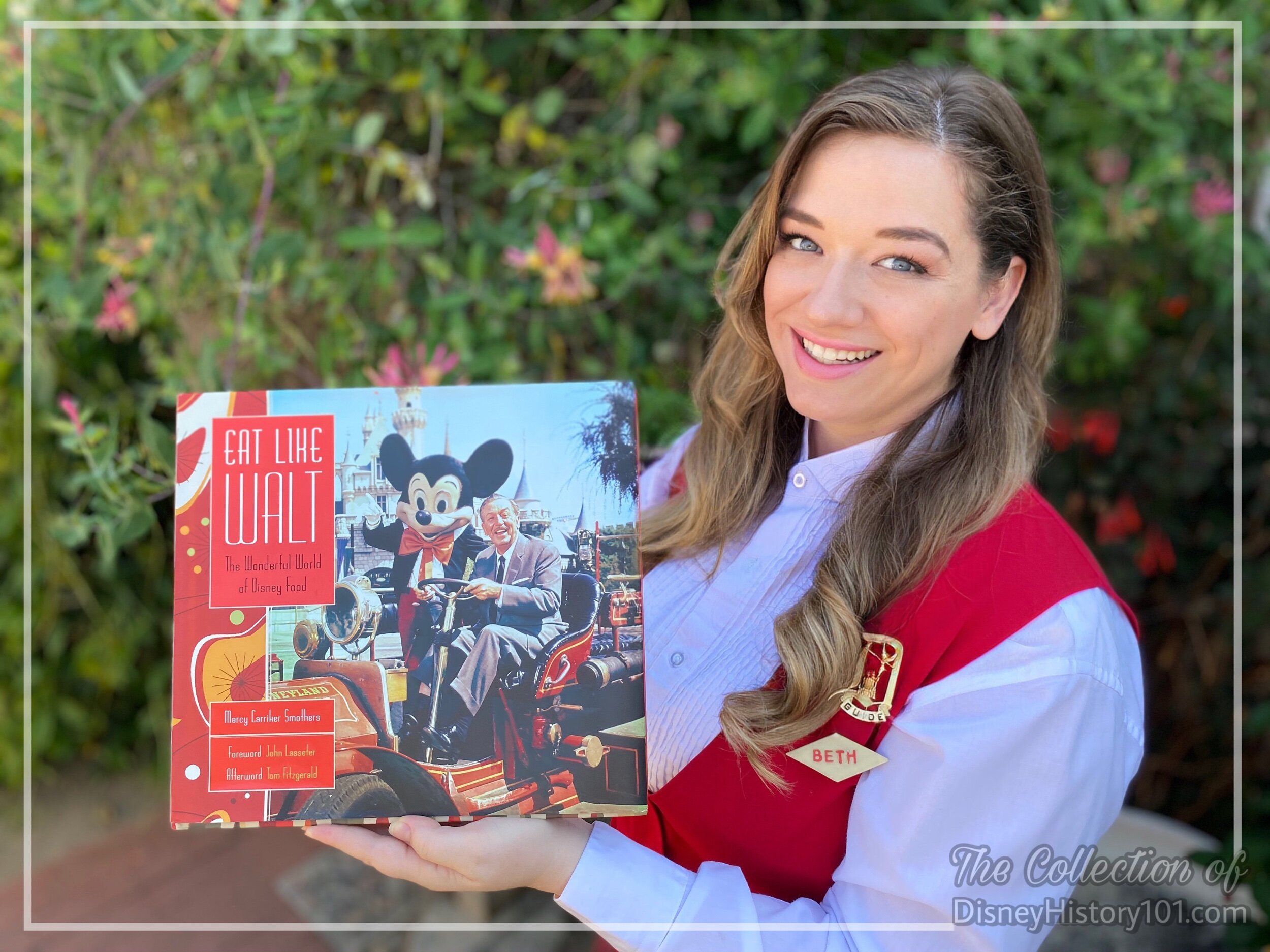
If you would like to read more about the Coca-Cola Refreshment Corner, it’s my pleasure to recommend adding Marcy Smothers’ “Eat Like Walt - The Wonderful World of Disney Food” to your personal Disney Home Library! Therein, Marcy has extensively researched and finely crafted a small section of a chapter dedicated to “Walt Disney’s Disneyland - Main Street U.S.A.” If you would like to bring the magic of Disneyland restaurants and concessions to your dining room table, “please step this way” toward www.eatlikewalt.com where Marcy has shared a few recipes for memorable Disneyland menu options, so you too can “Eat Like Walt.”
The Coke Corner would have a legacy at the Magic Kingdom. There, ragtime piano music kept spirits high on the way to Cinderella Castle.
When Tokyo Disneyland opened on April 15, 1983, the Coca-Cola Refreshment Corner would have a legacy of sorts with the Refreshment Corner specializing in hot dogs served with sides of chips, beverages and real “ragtime” piano. The restaurant would also have a legacy at Hong Kong Disneyland, through Main Street Corner Cafe Hostel by Coca-Cola. There, guests could enjoy an “innovative special menu blending together the popular beverage with good old western ‘comfort food’ in this first Coca-Cola themed restaurant launched in Hong Kong.”

Coca-Cola Refreshment Corner in the Present Day.
During the 2000s, the Refreshment Corner received eye-catching new paint and a “Coke bottle green”-inspired terrazzo floor that leads to the Candy Palace.
In maintaining the magic after the Park closes, the staff take over with brooms, mops and dustcloths. Special attention was given to marred walls, posts and furniture. Items with marks that didn’t wash off were replaced or repainted. The Floors were waxed and buffed to preserve their beauty and protect them from the thousands of feet that scuffle over them each day.
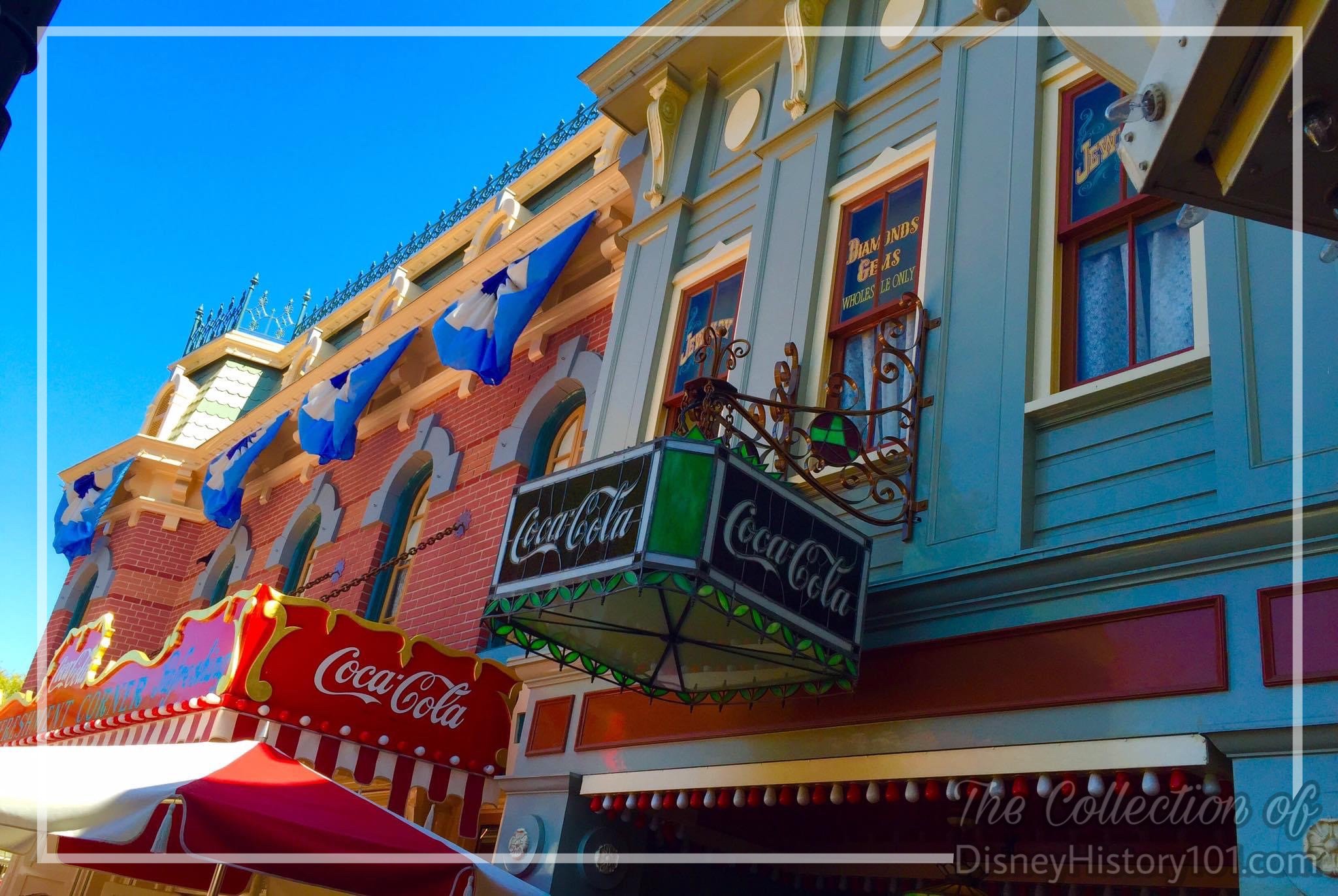
A Coca-Cola Refreshment Corner Lamp in the Present Day.
“We celebrate our people for the memories they created in the past.”
Martin Sklar once said “an individual's contribution can usually be found in the final product if one looks closely enough, but the Disney mind frame is to never point out ‘what I did’ to anyone.” However, a few outstanding individuals have been publicly recognized for their contributions and even ceremoniously honored by the Company.
There are thousands of windows at Disneyland.
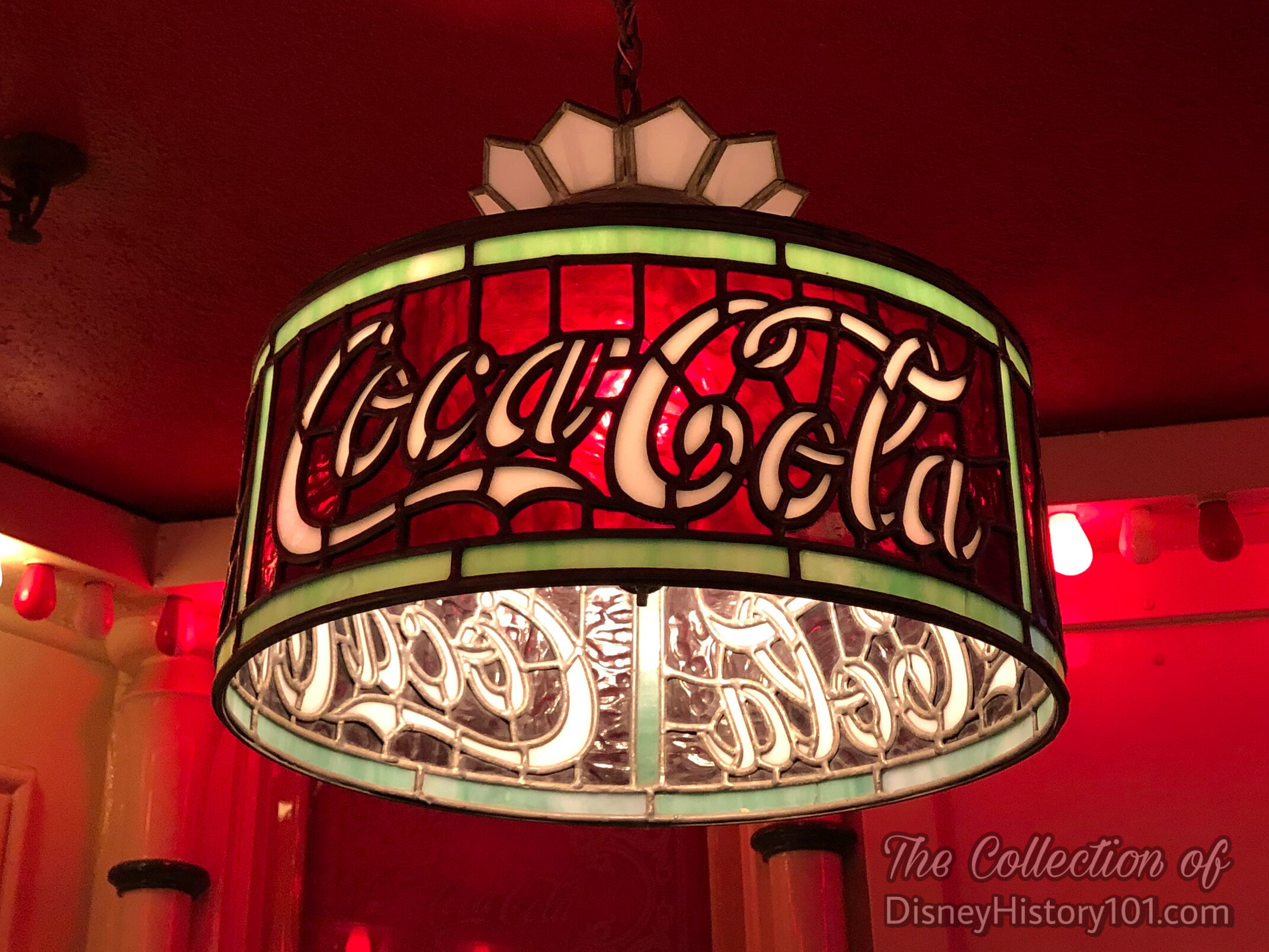
Marshall Lane’s Coca-Cola Refreshment Corner Lamp design lives on at Disneyland in the present.
“Illumination”
Back in 1951, Art Linkletter was touring with Walt in Europe, and they visited the famous entertainment complex Tivoli Gardens in Copenhagen. Art noticed that Walt was jotting things down in a notebook as they were walking along. Art noticed that Walt “was struck by the fact that the park featured millions and millions of lights and that crews were constantly on patrol to service them.” This would influence Walt’s vision for Main Street U.S.A. at Disneyland.
On Main Street U.S.A., Details paint the story. Note the two separate types of lighting in and outside the Coca-Cola Corner restaurant: Character Lighting, and Functional Lighting. Character lighting is themed to the area to enhance the overall appearance and complement the interior, such as a chandelier or kerosene lamp. These add to the show, but don't necessarily create enough illumination for operation.
Since the beginning, all fixtures (including Functional and Character lights) were placed in their correct motif and many light fixtures of Disneyland were authentic antiques. Others, like Marshall Lane’s original decorative character lighting element designs have remained constant features of Coca-Cola Refreshment Corner to the present. The former Walt Disney Imagineering Principal Creative Executive Marty Sklar would probably agree that the small details like these make the story appealing.
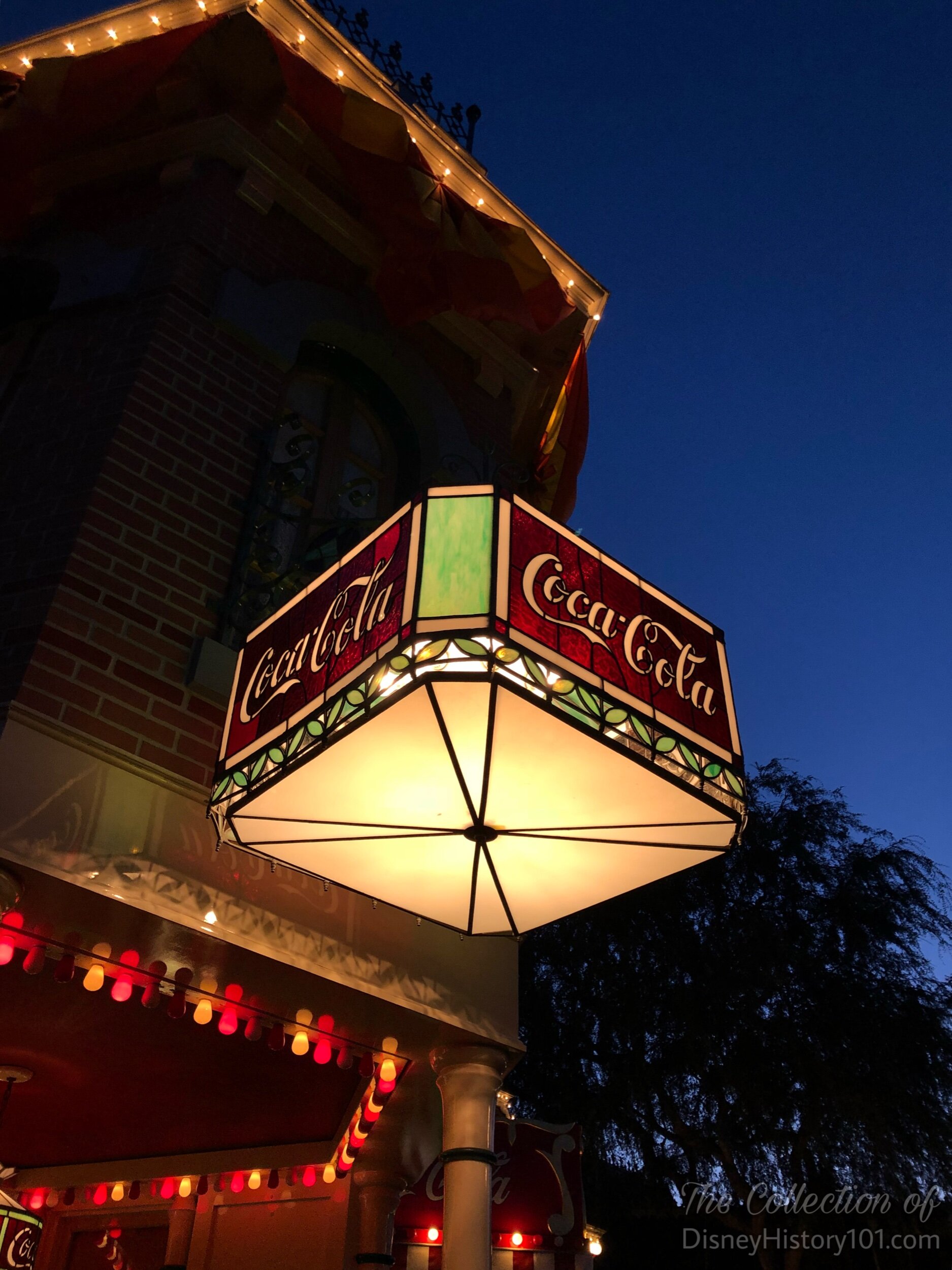
Coca-Cola Refreshment Corner Lamp
“The sign of good taste” in the present.
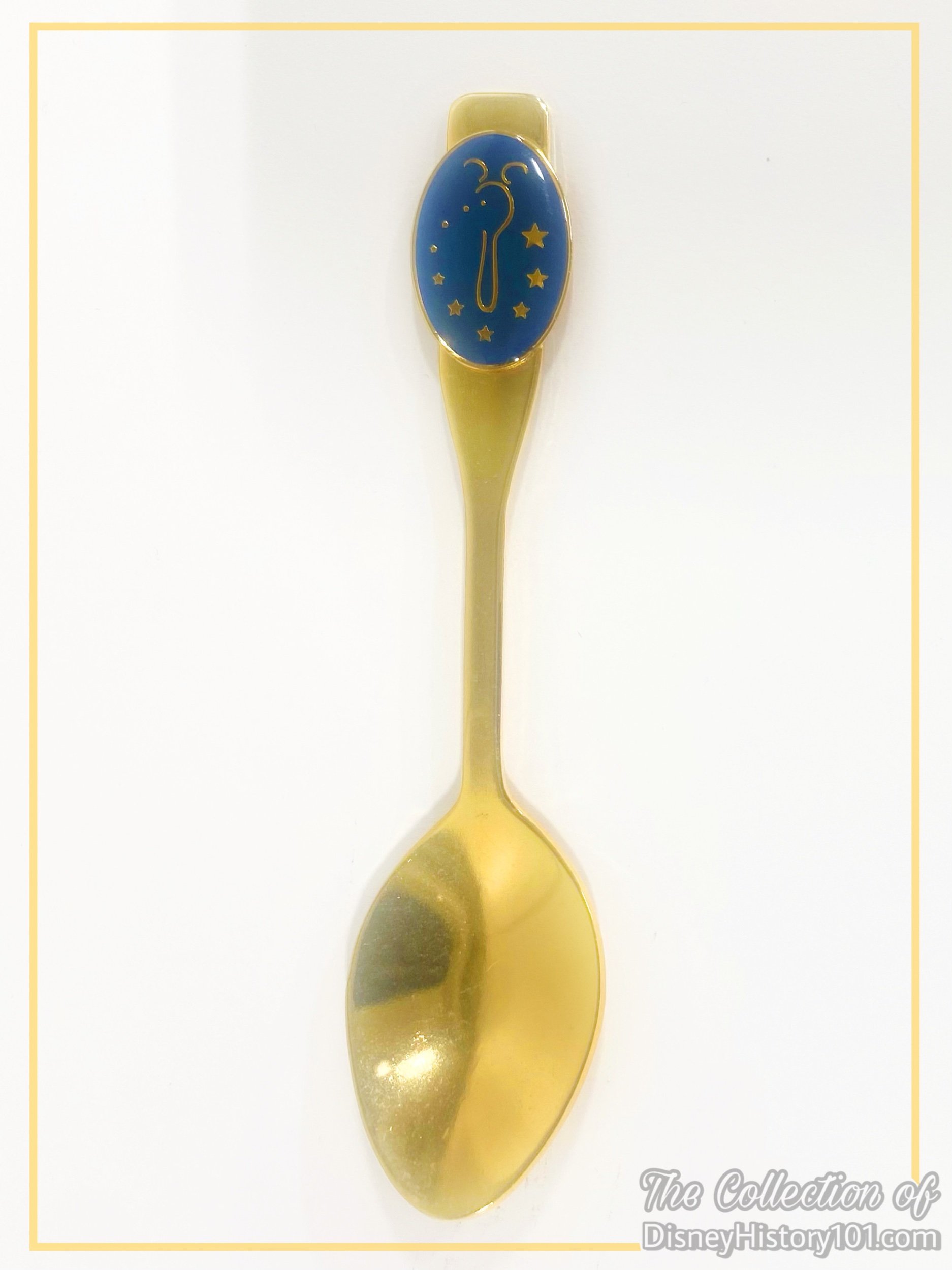
A Disneyland Food Operations Award, c.2000s.
